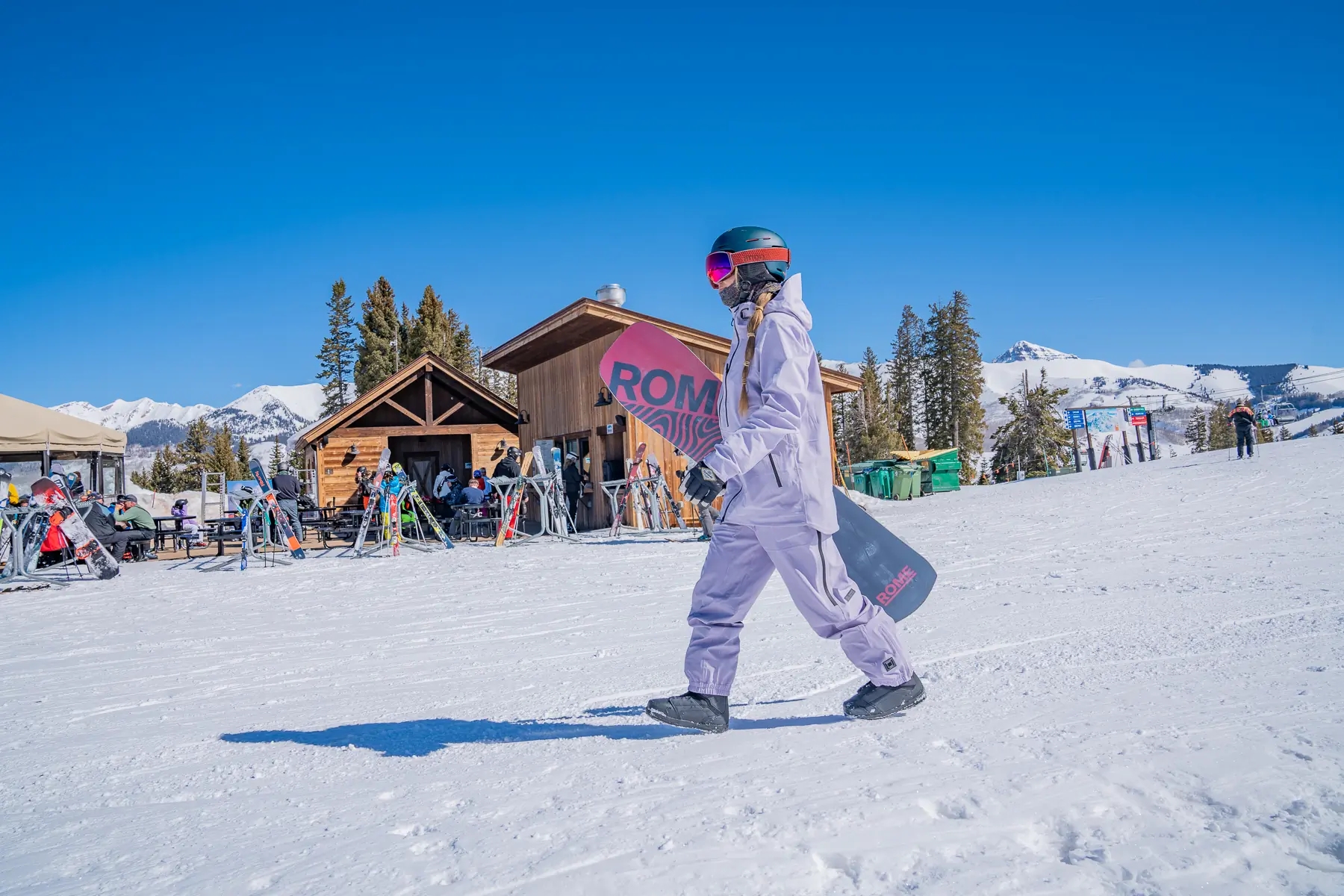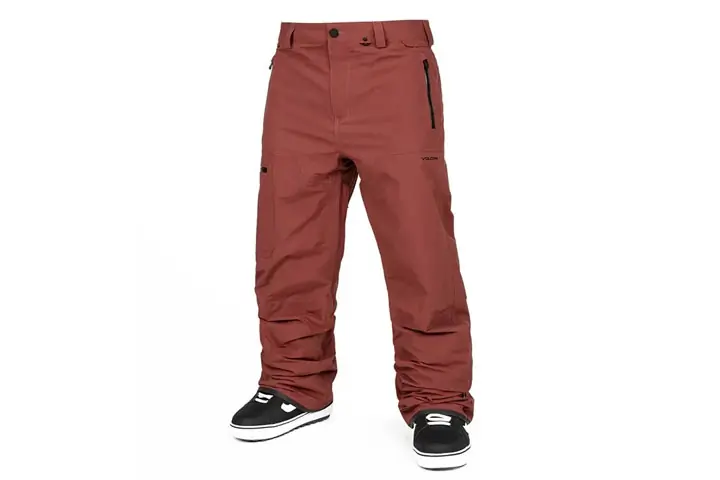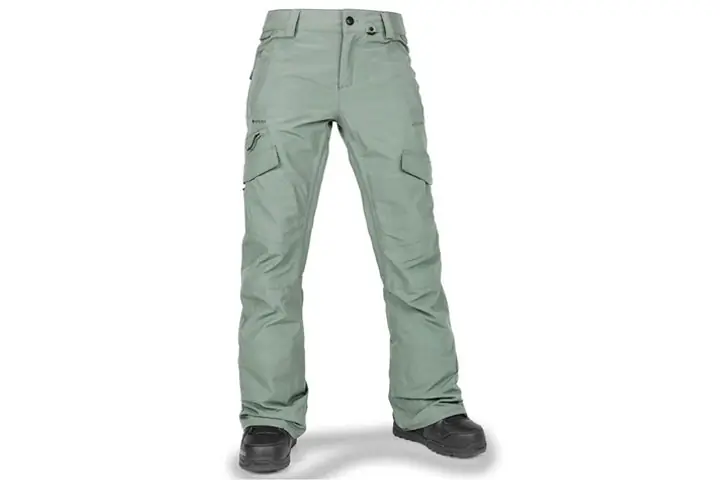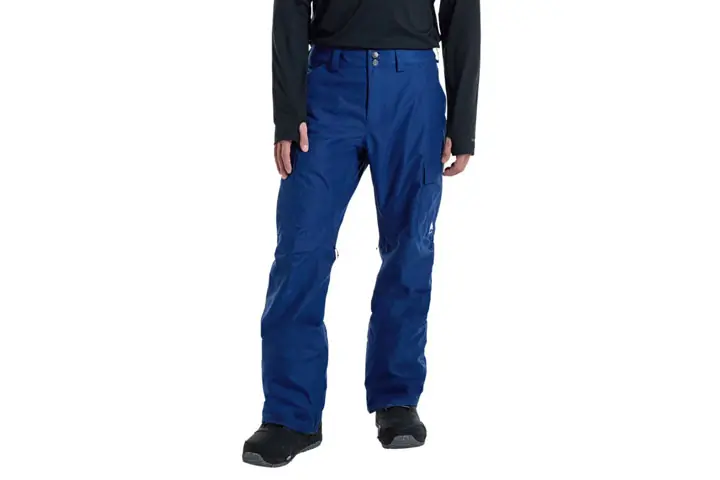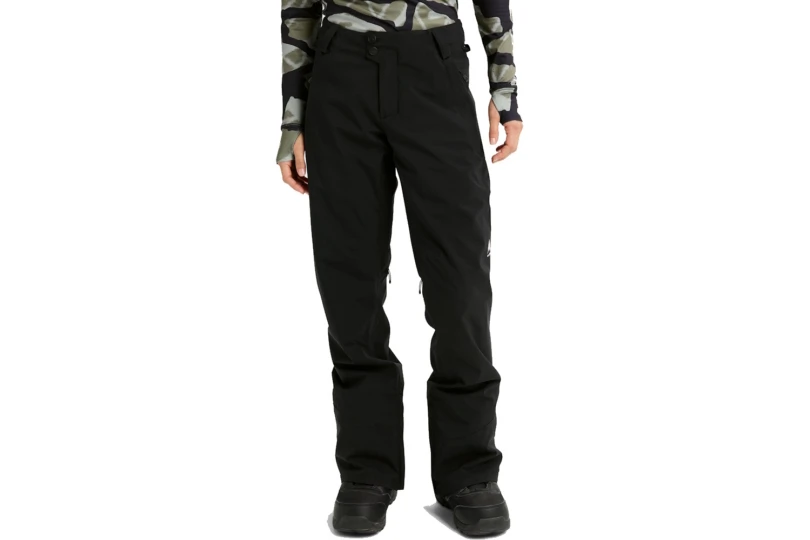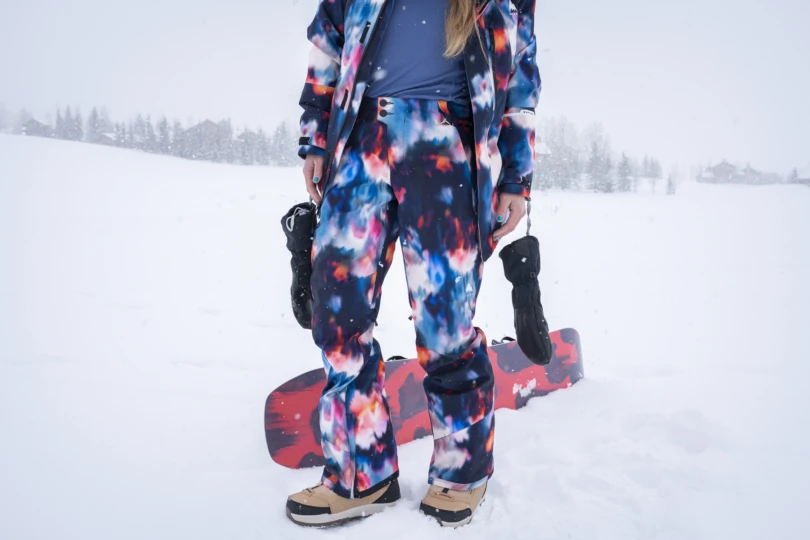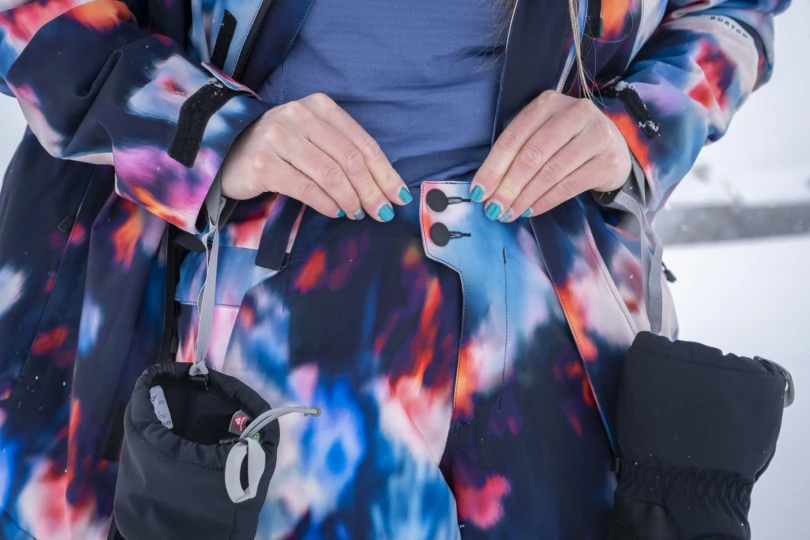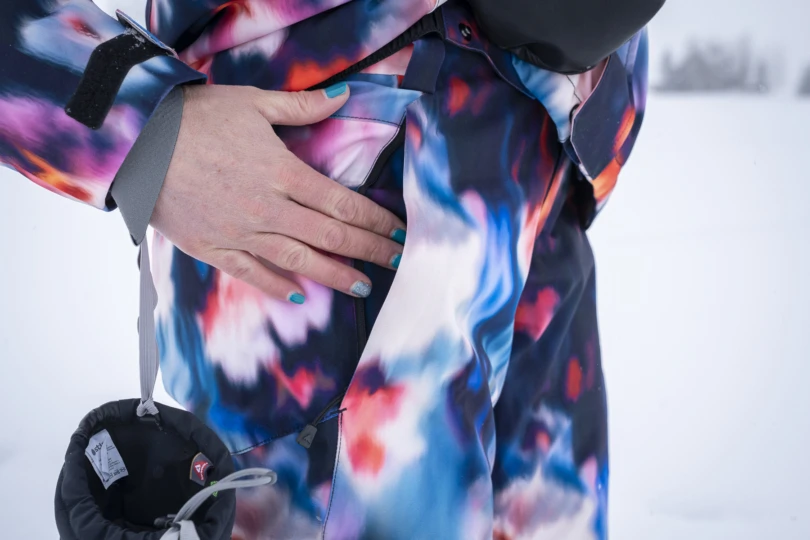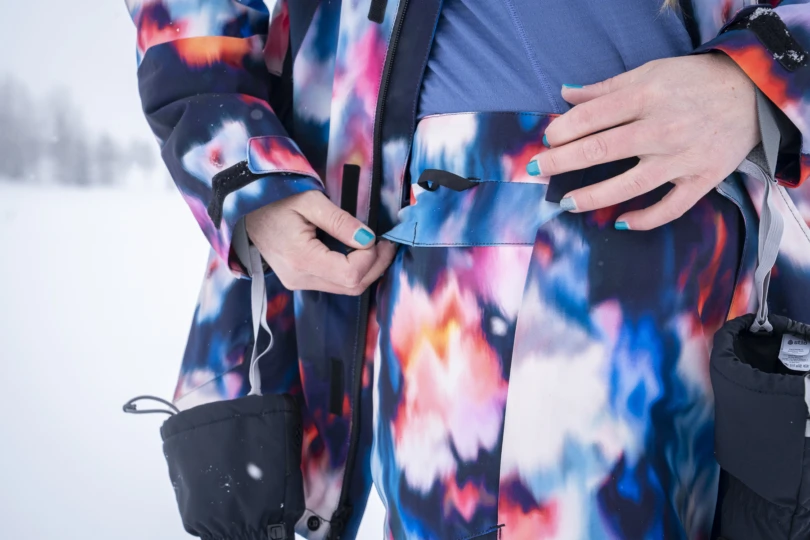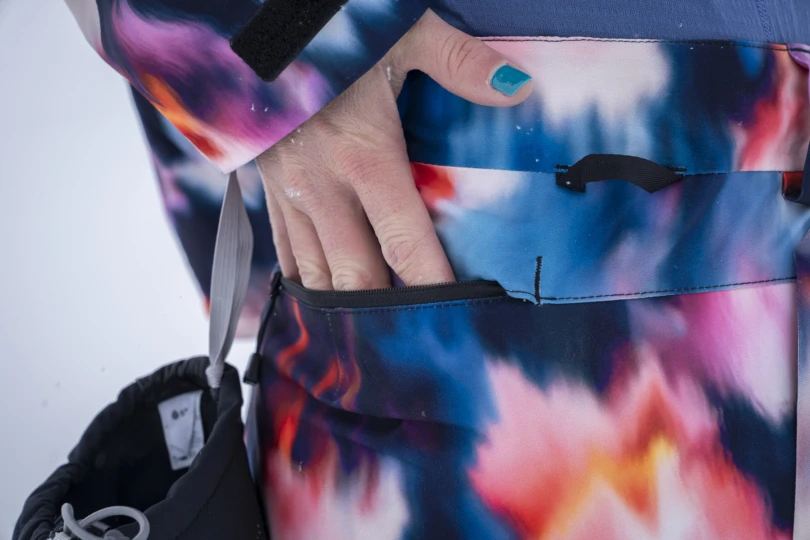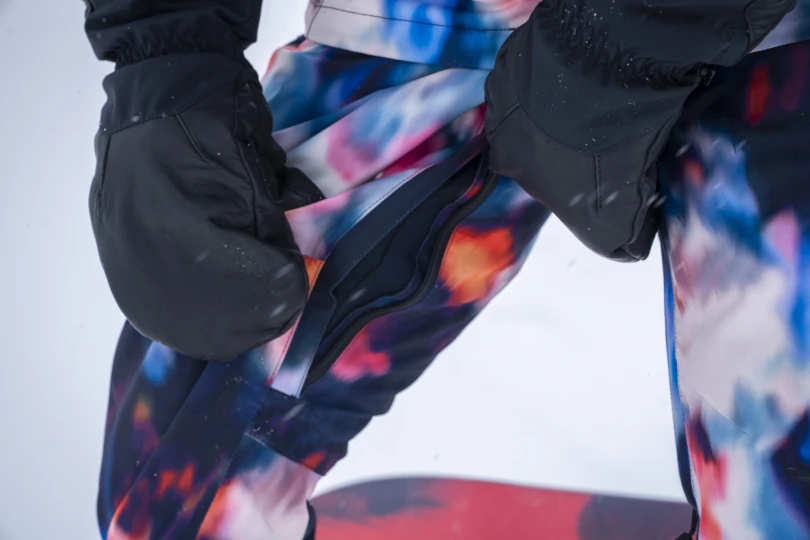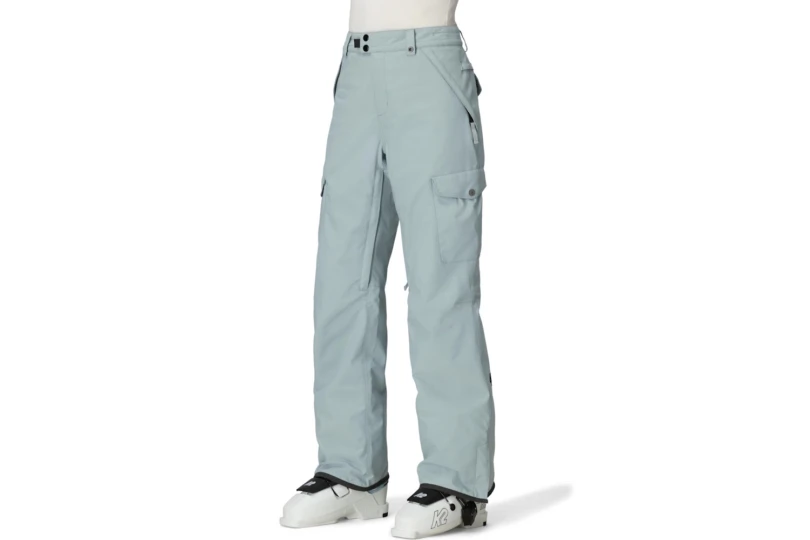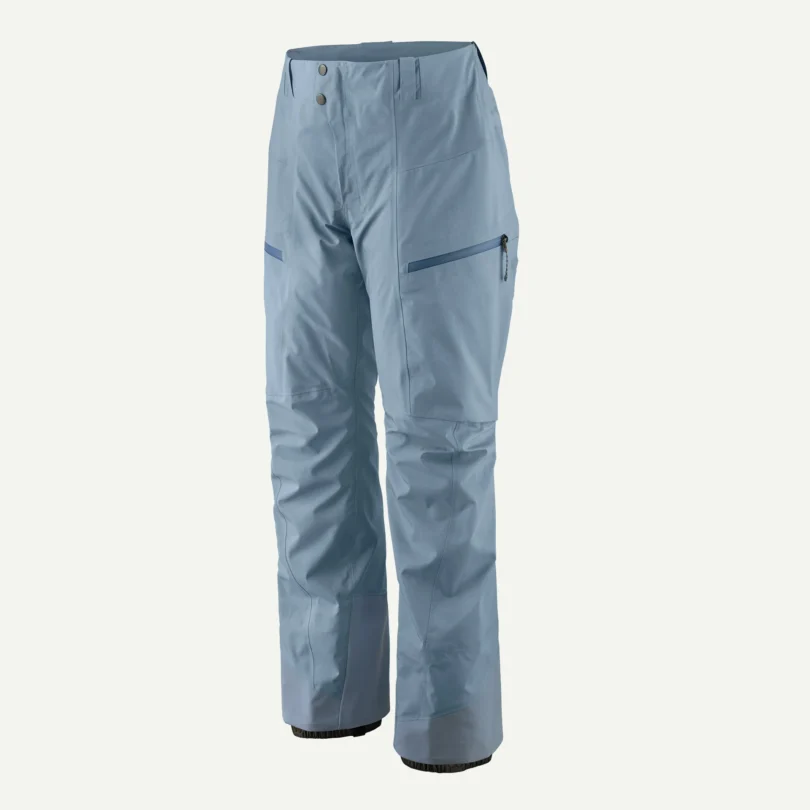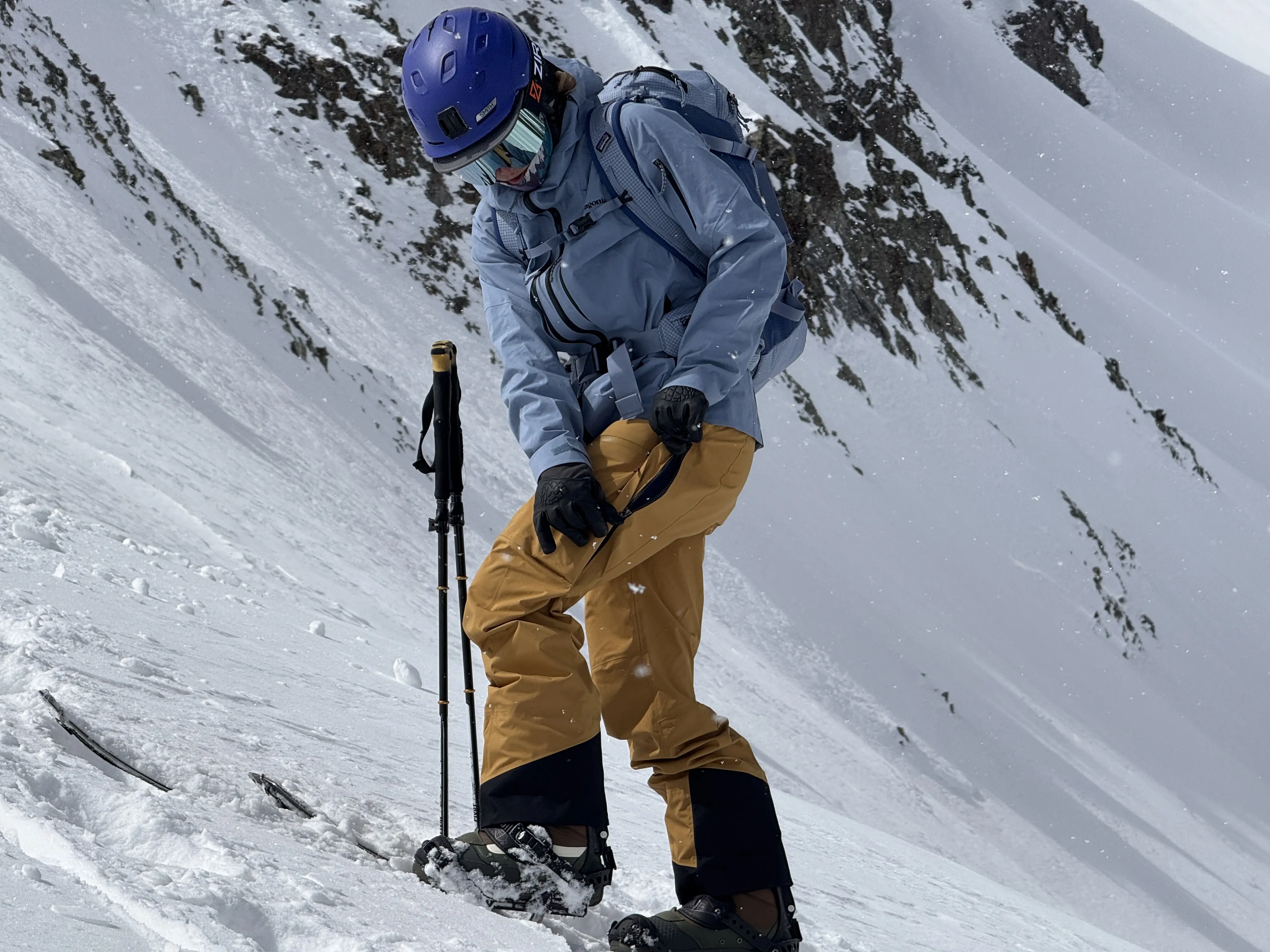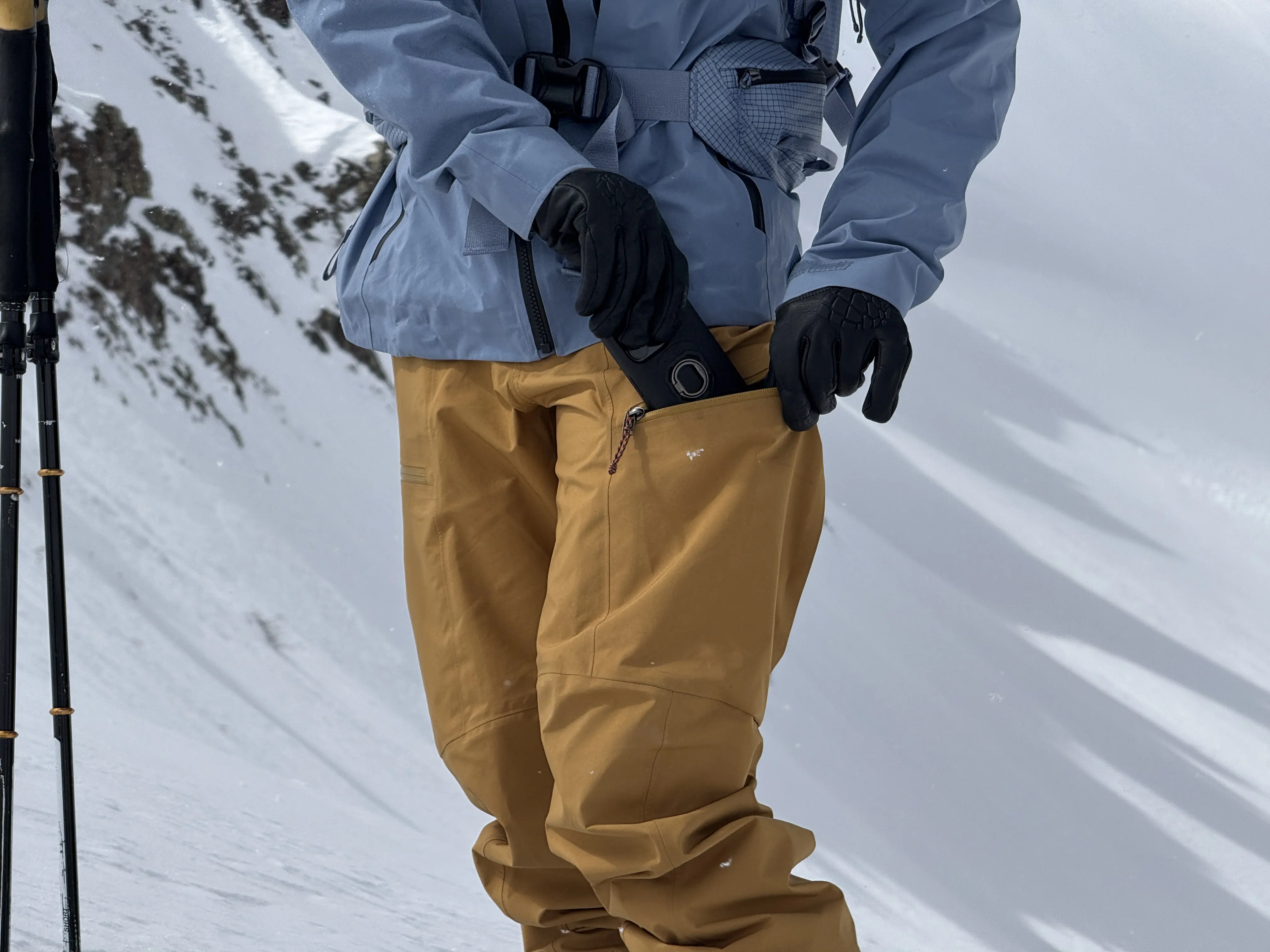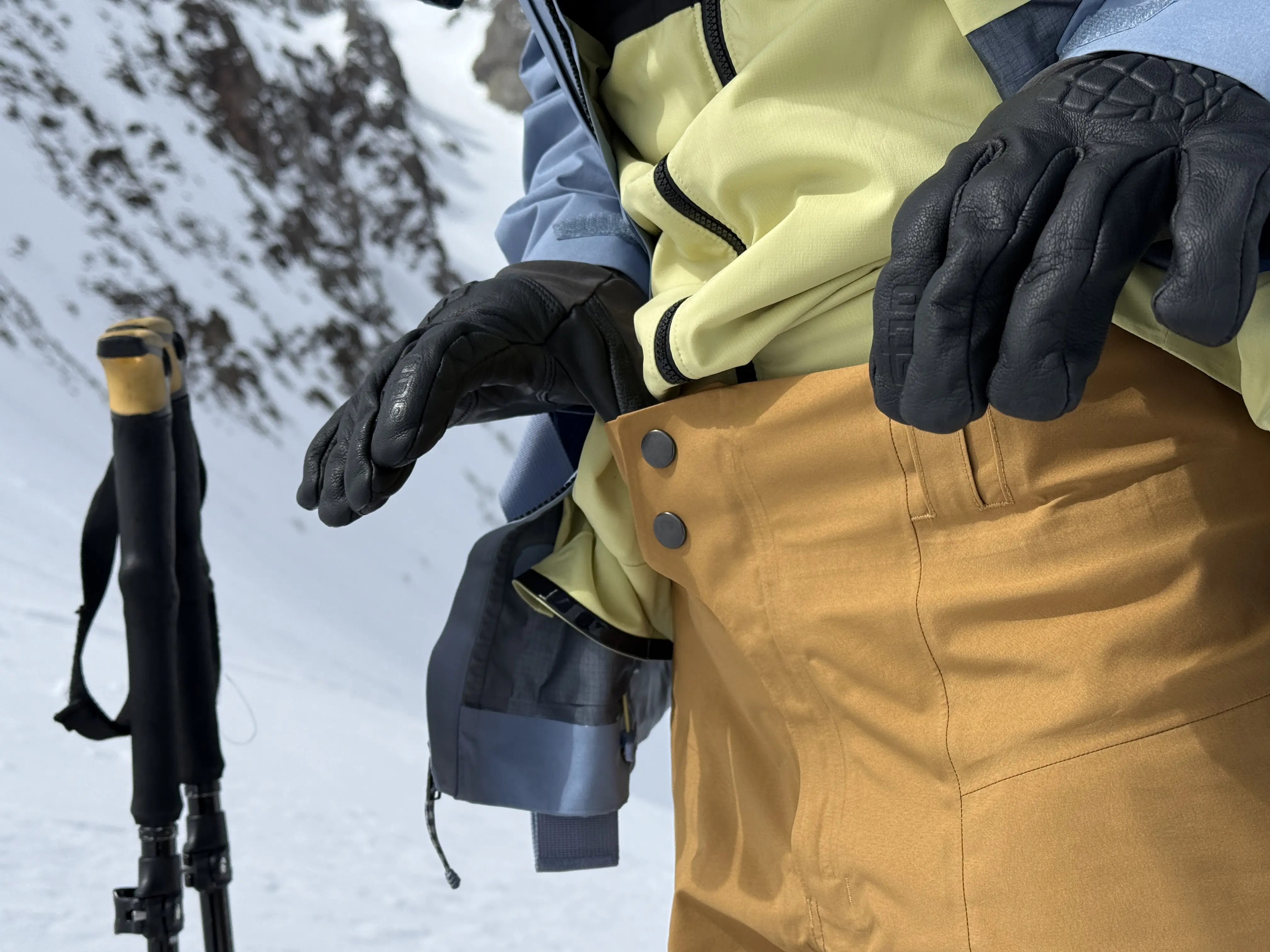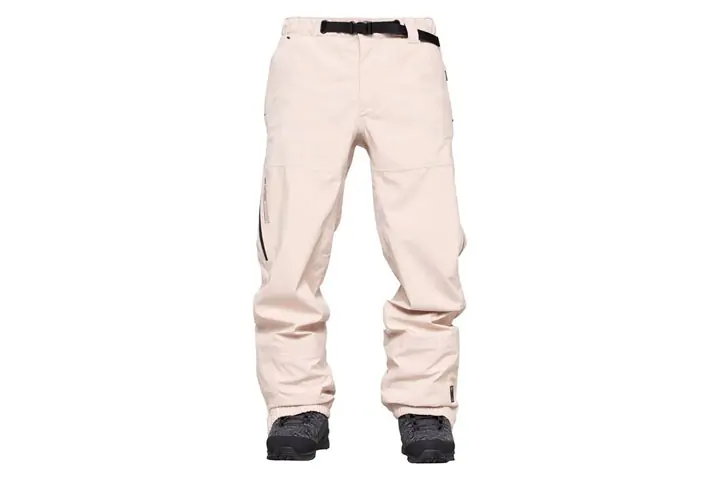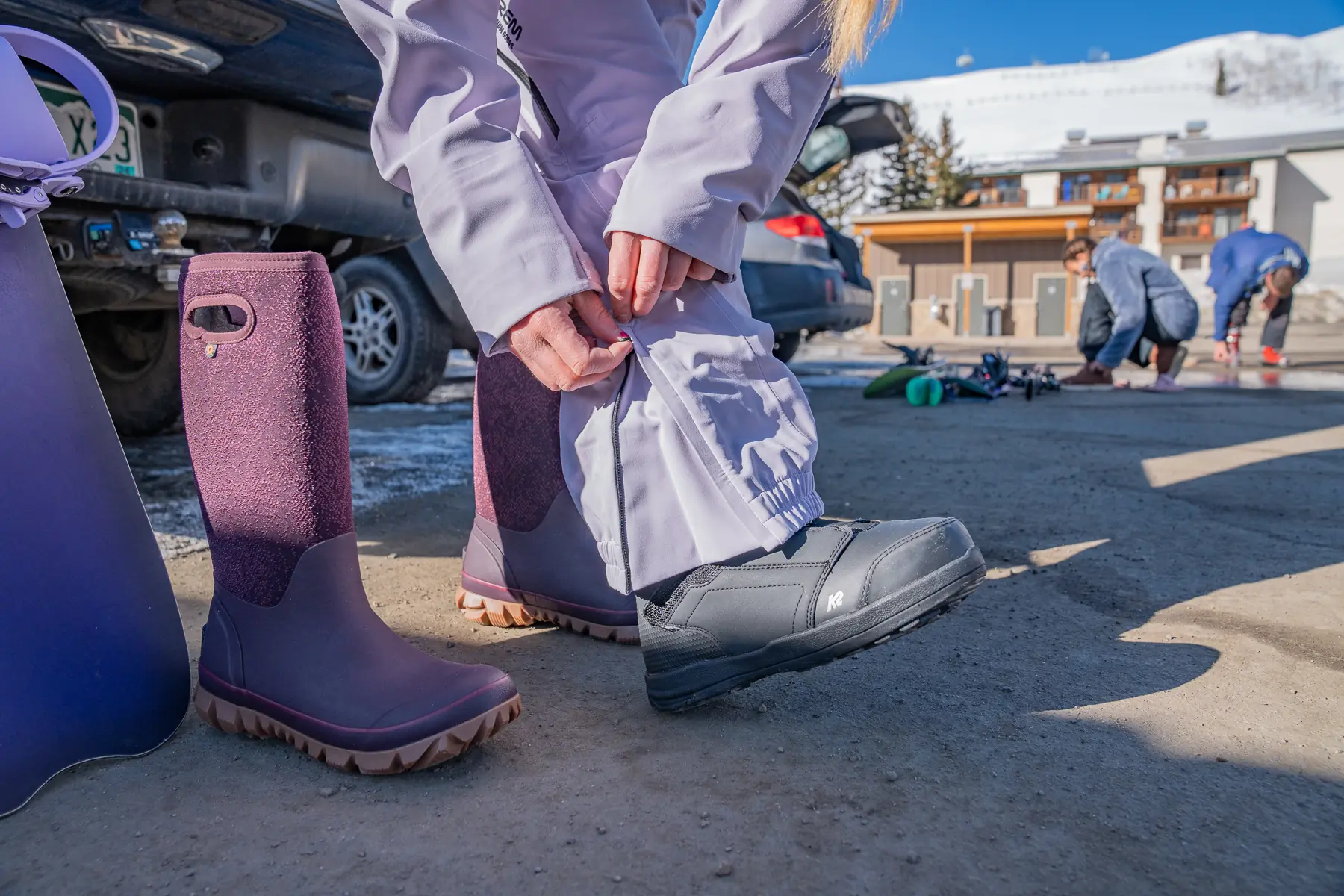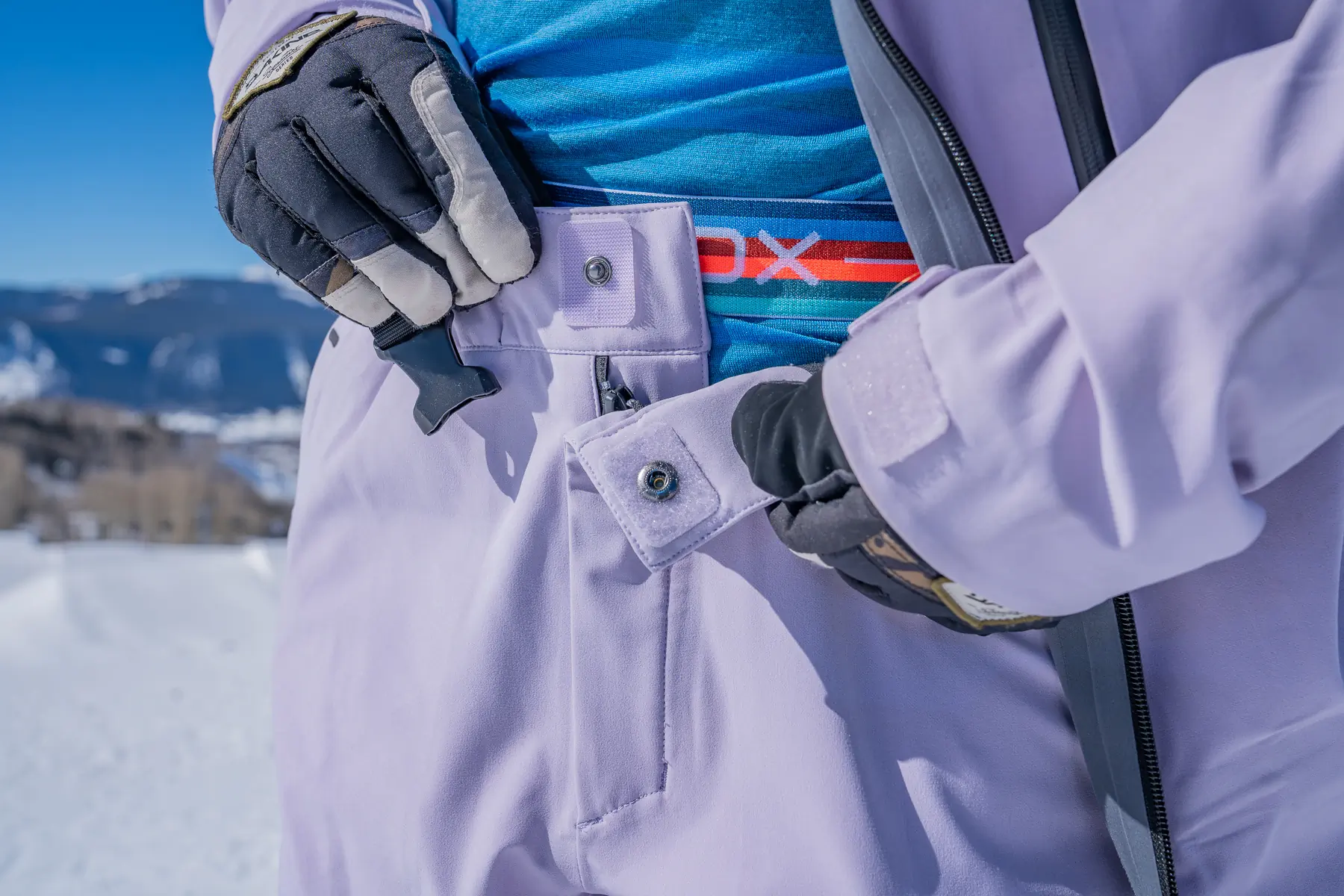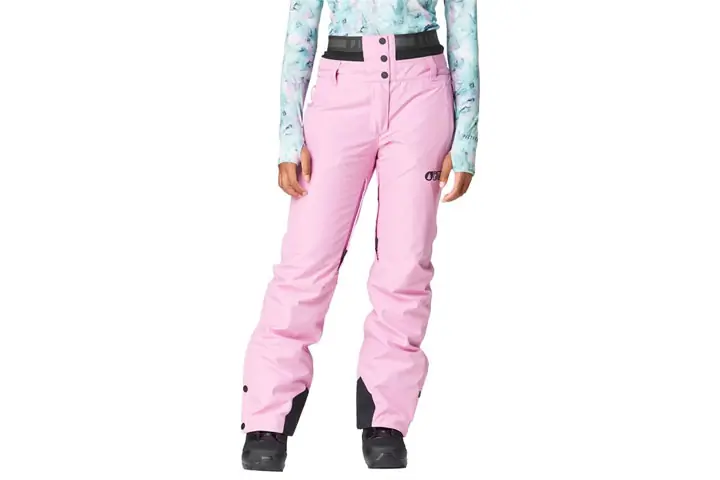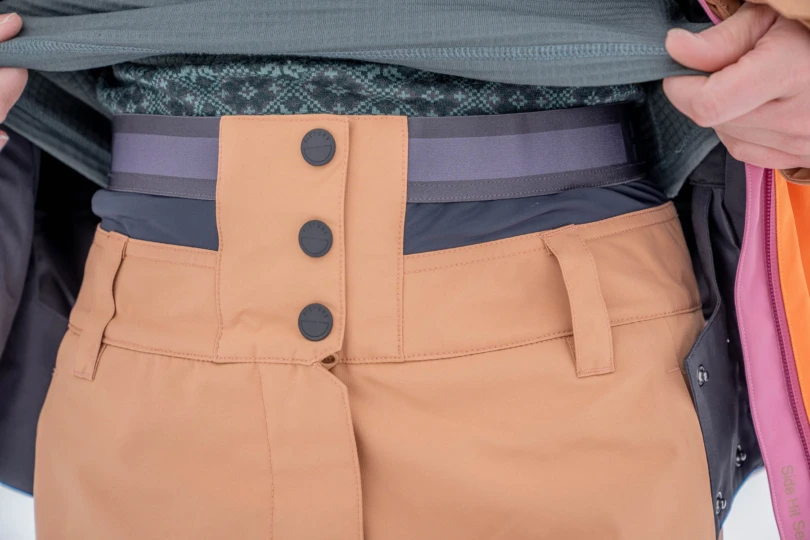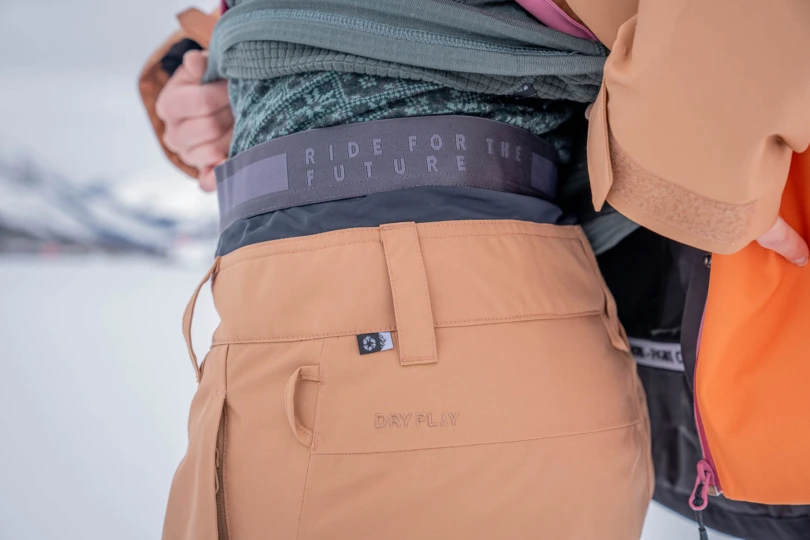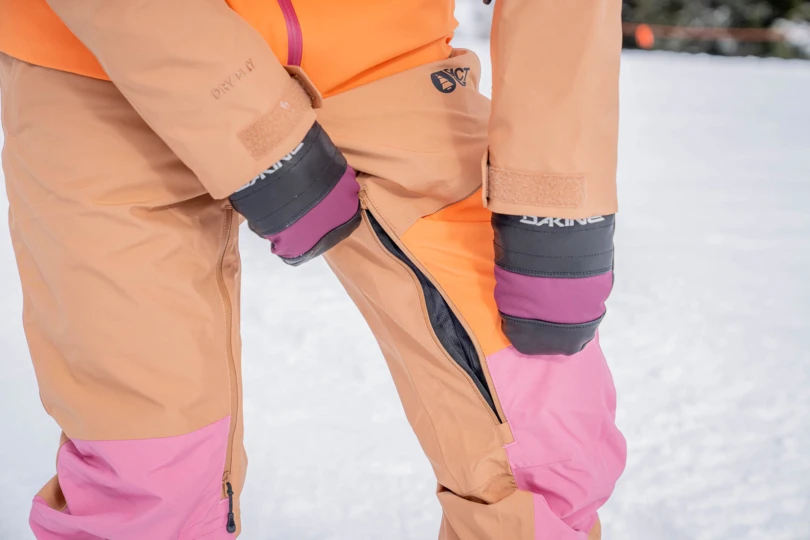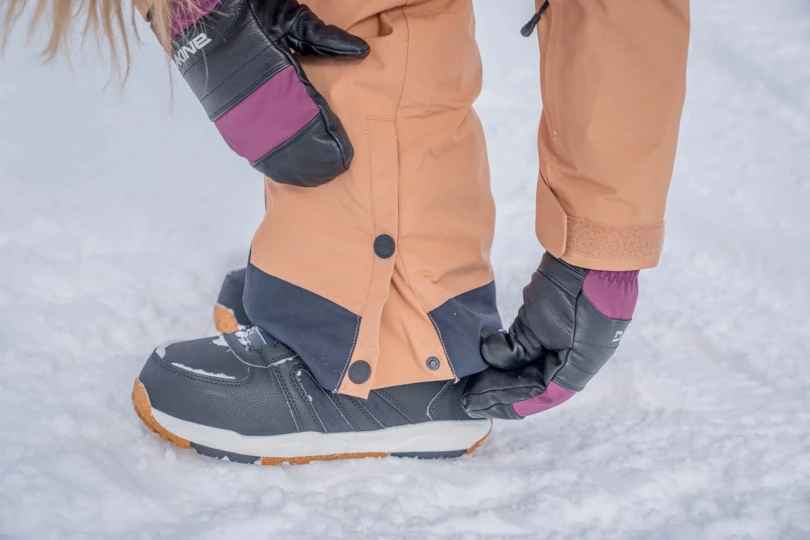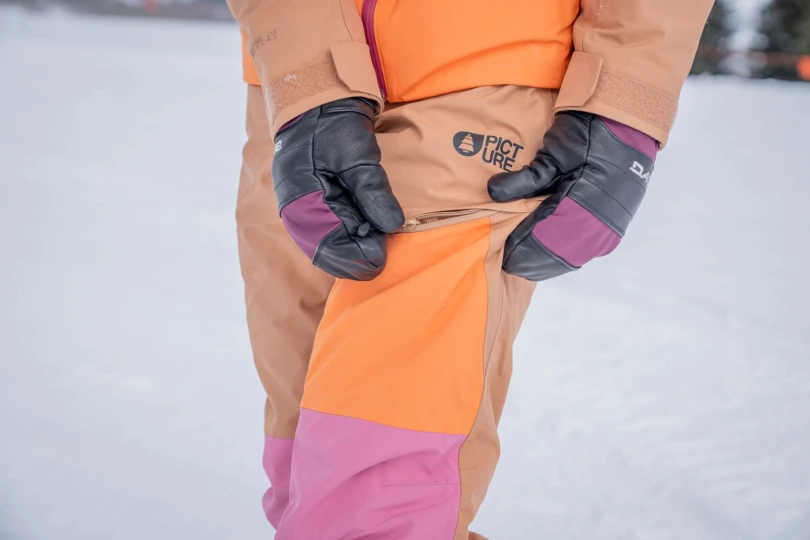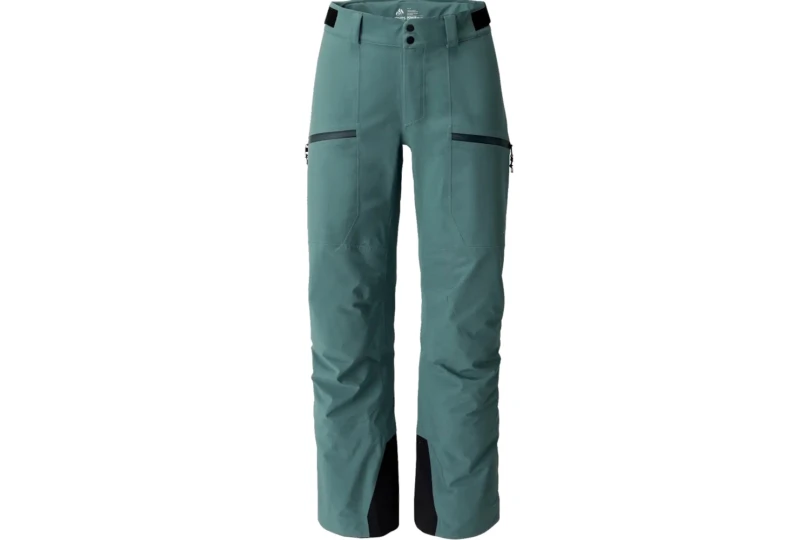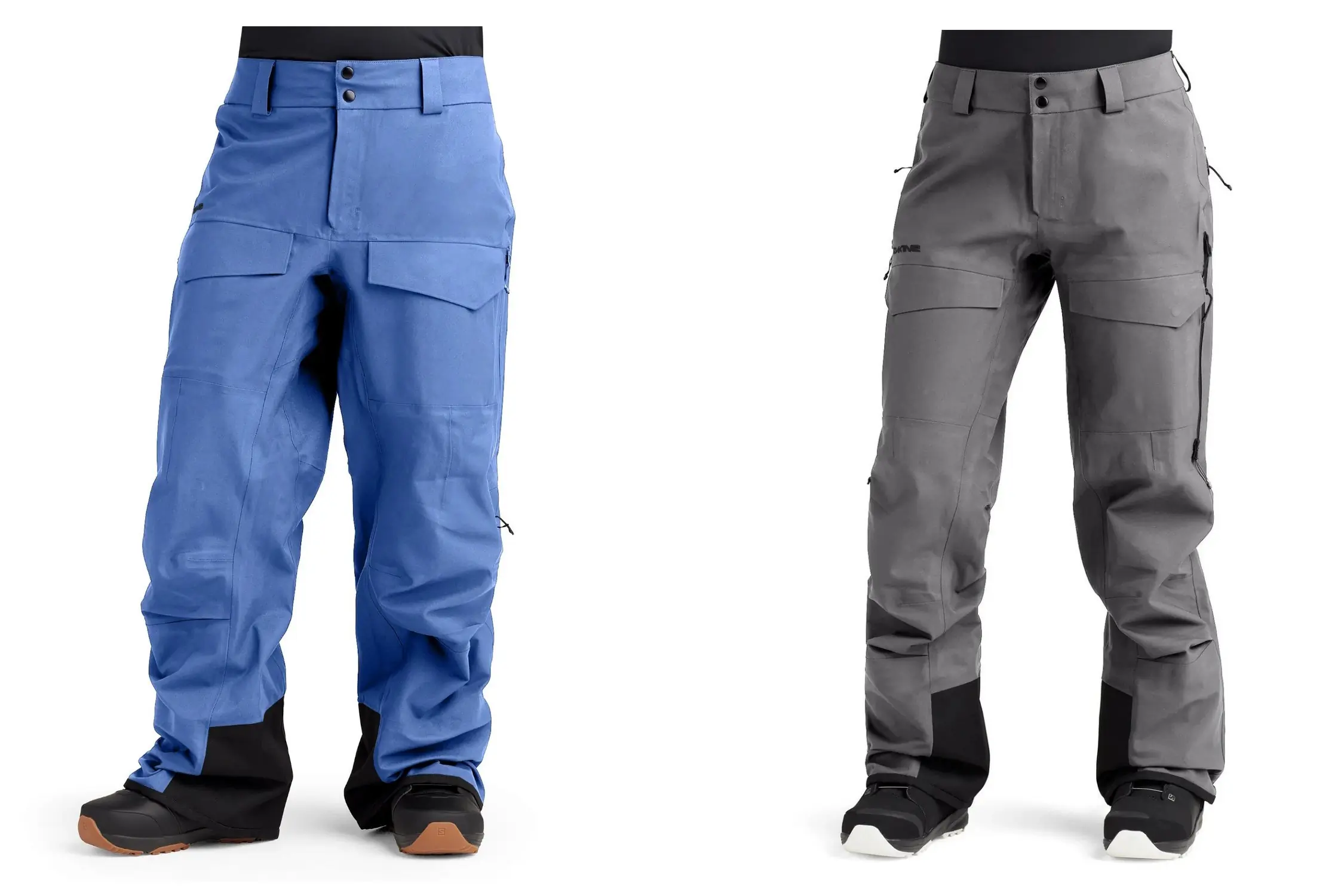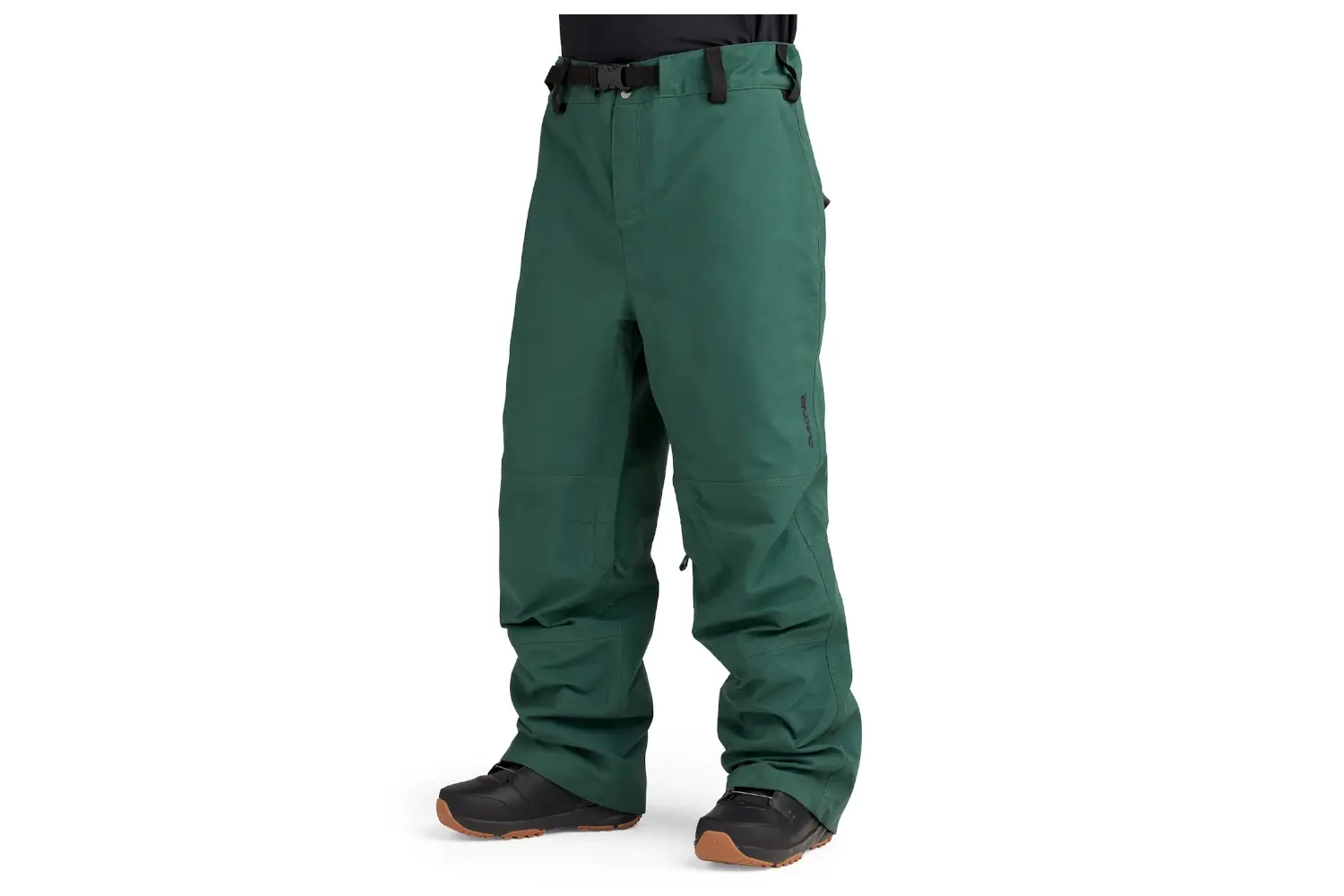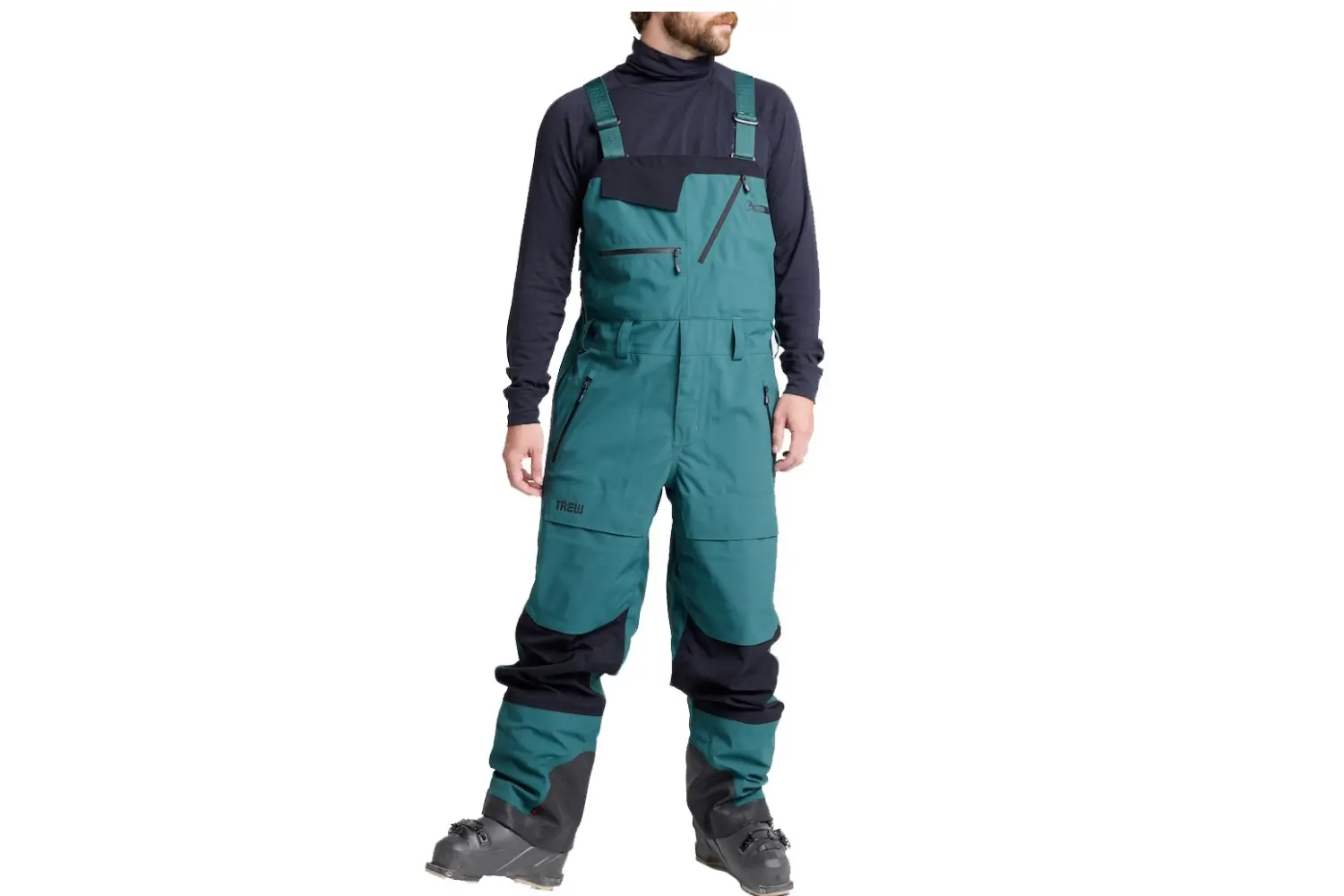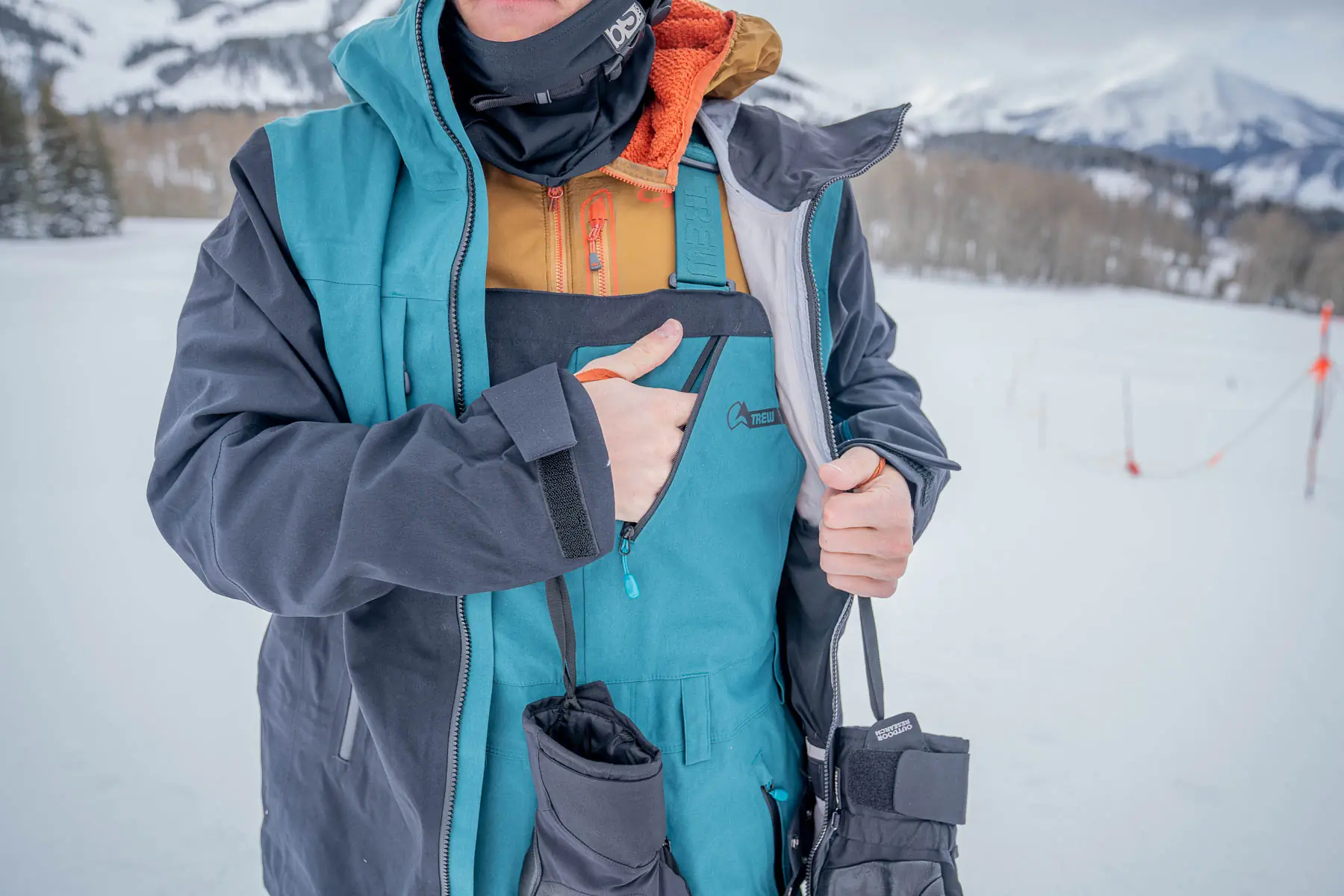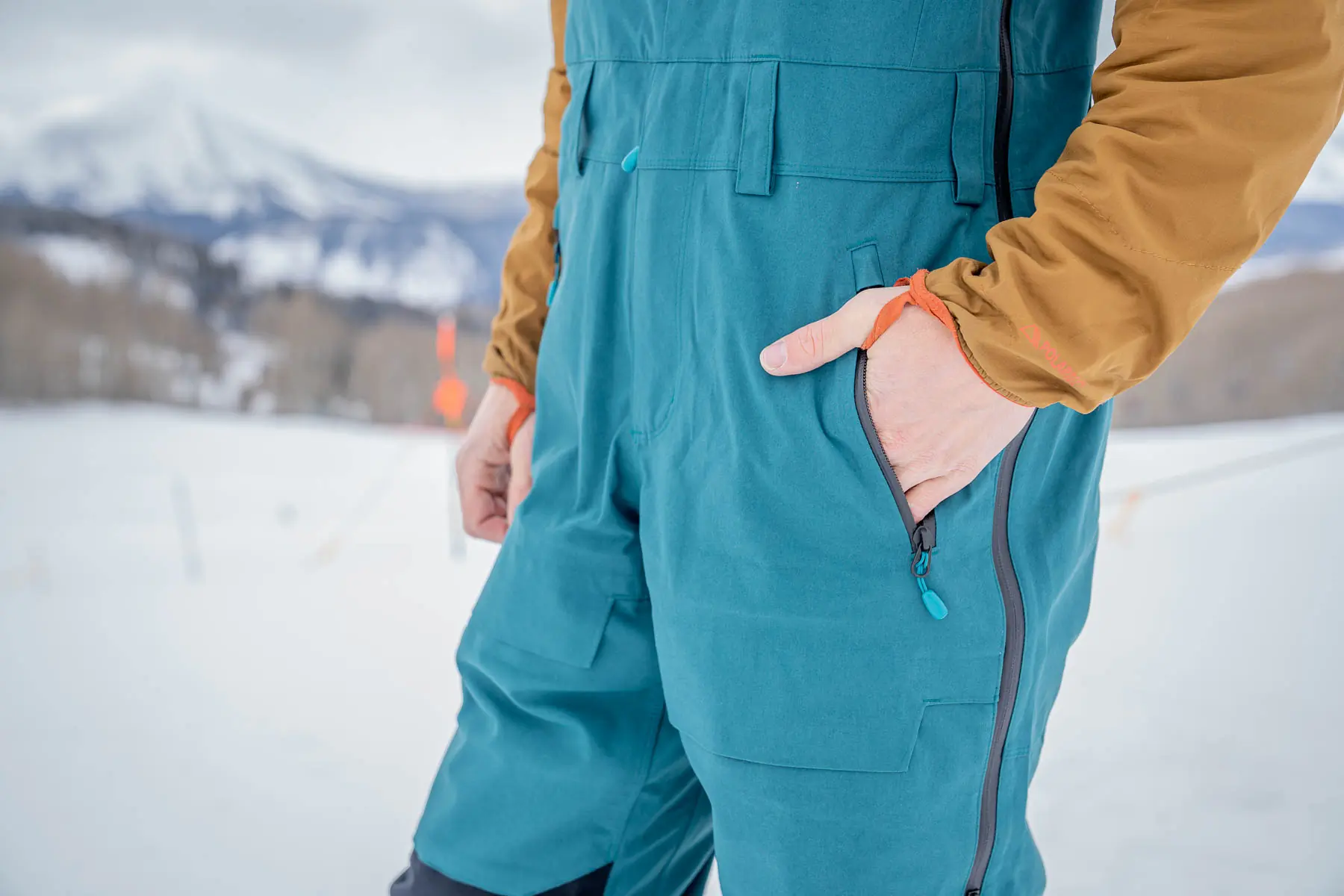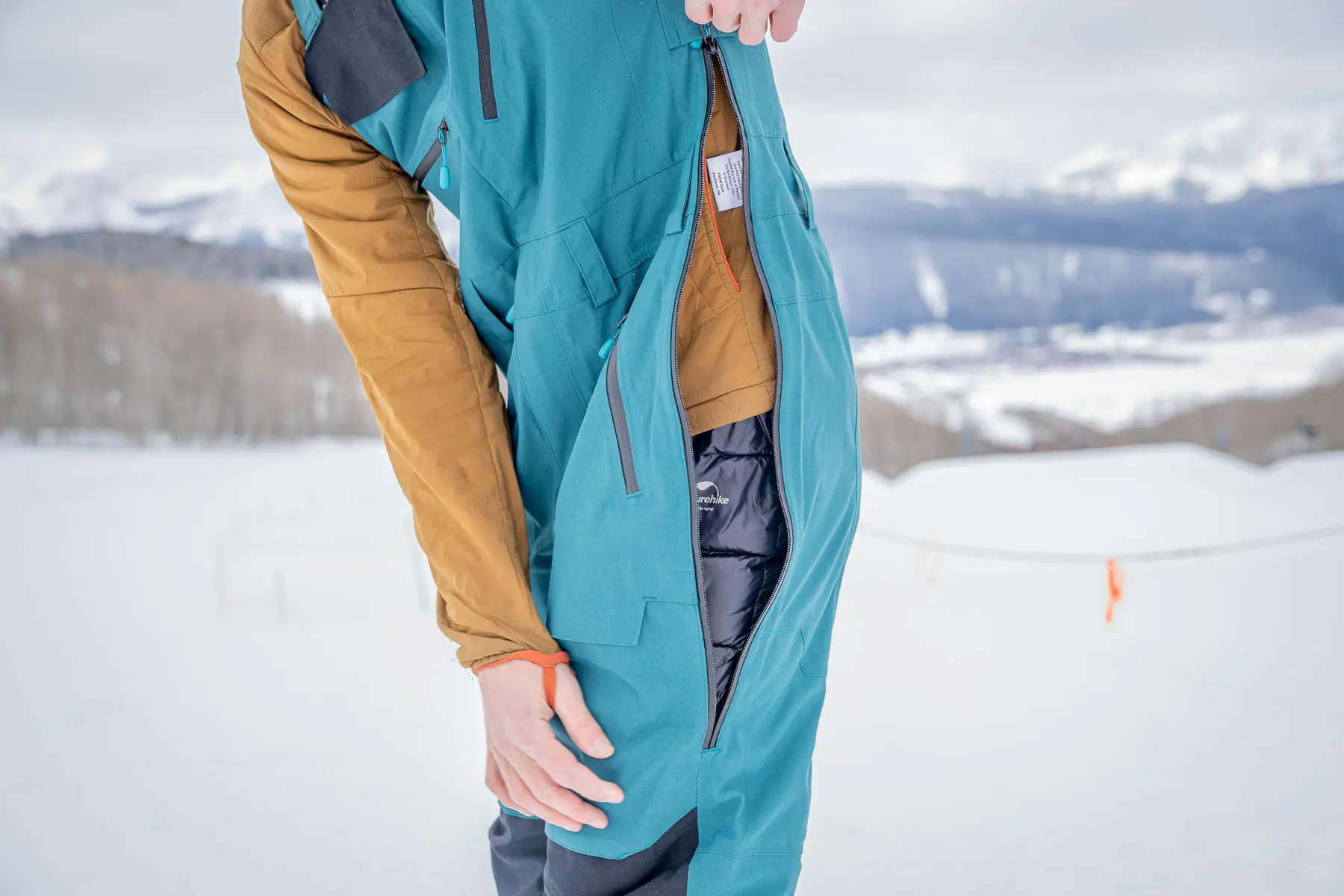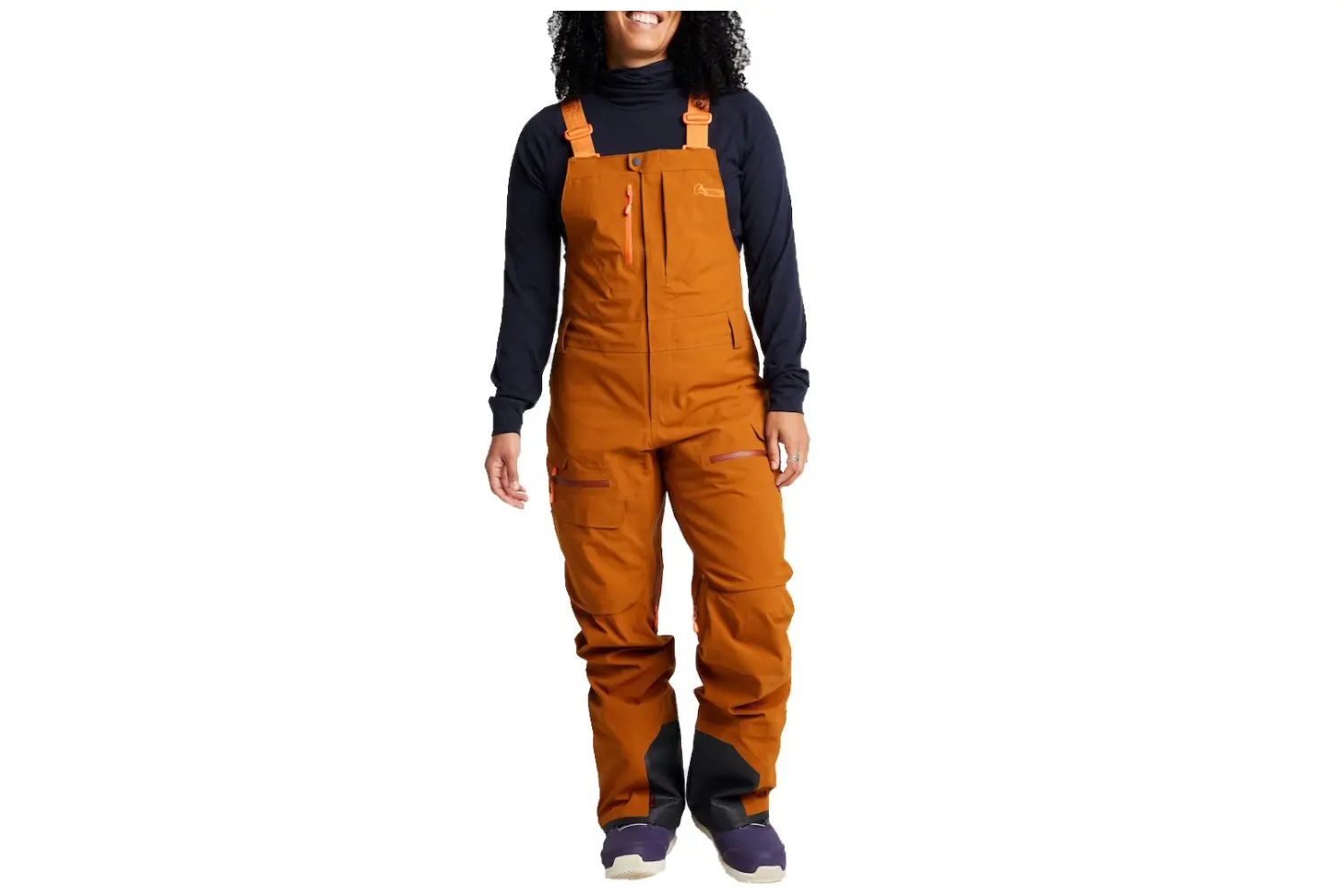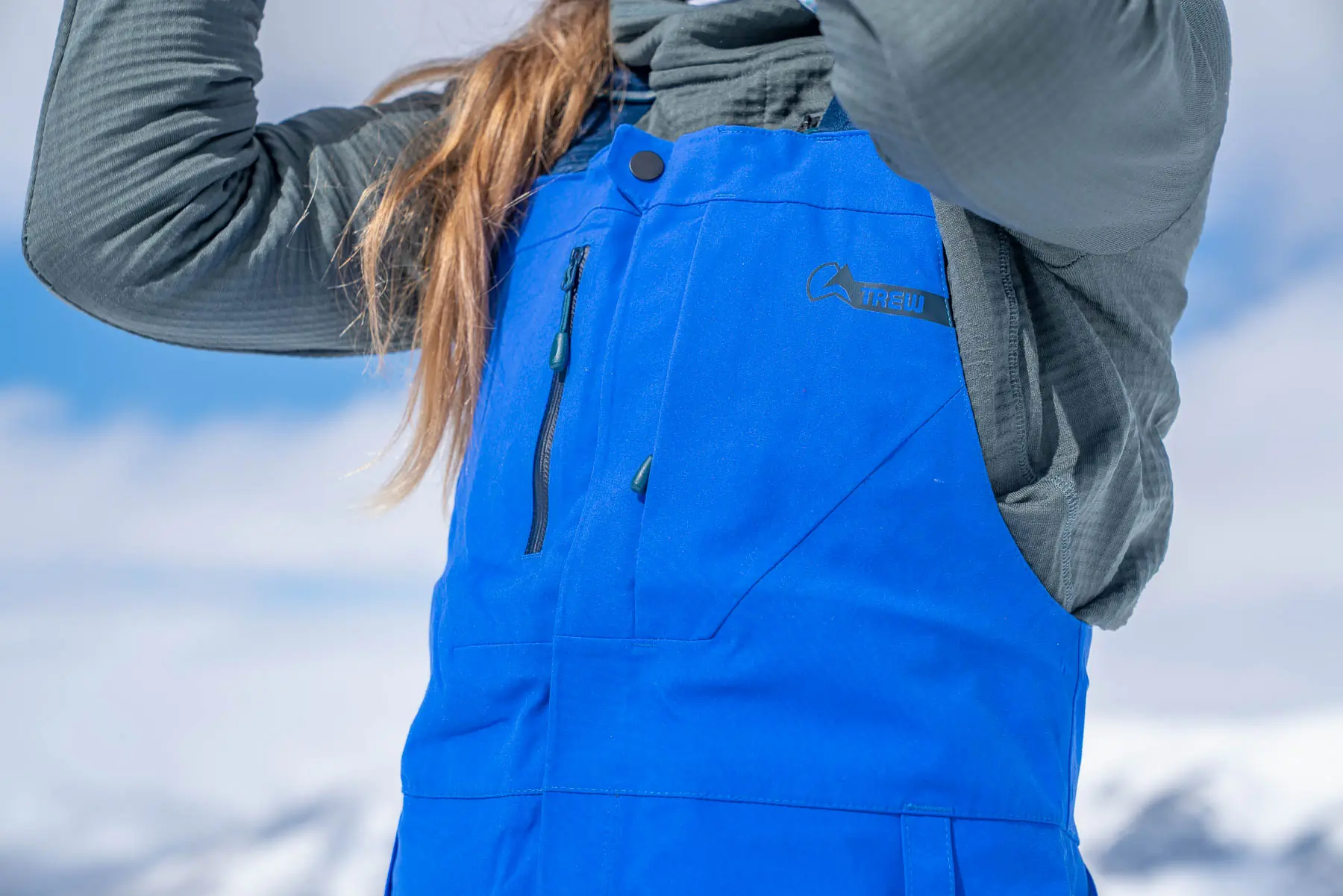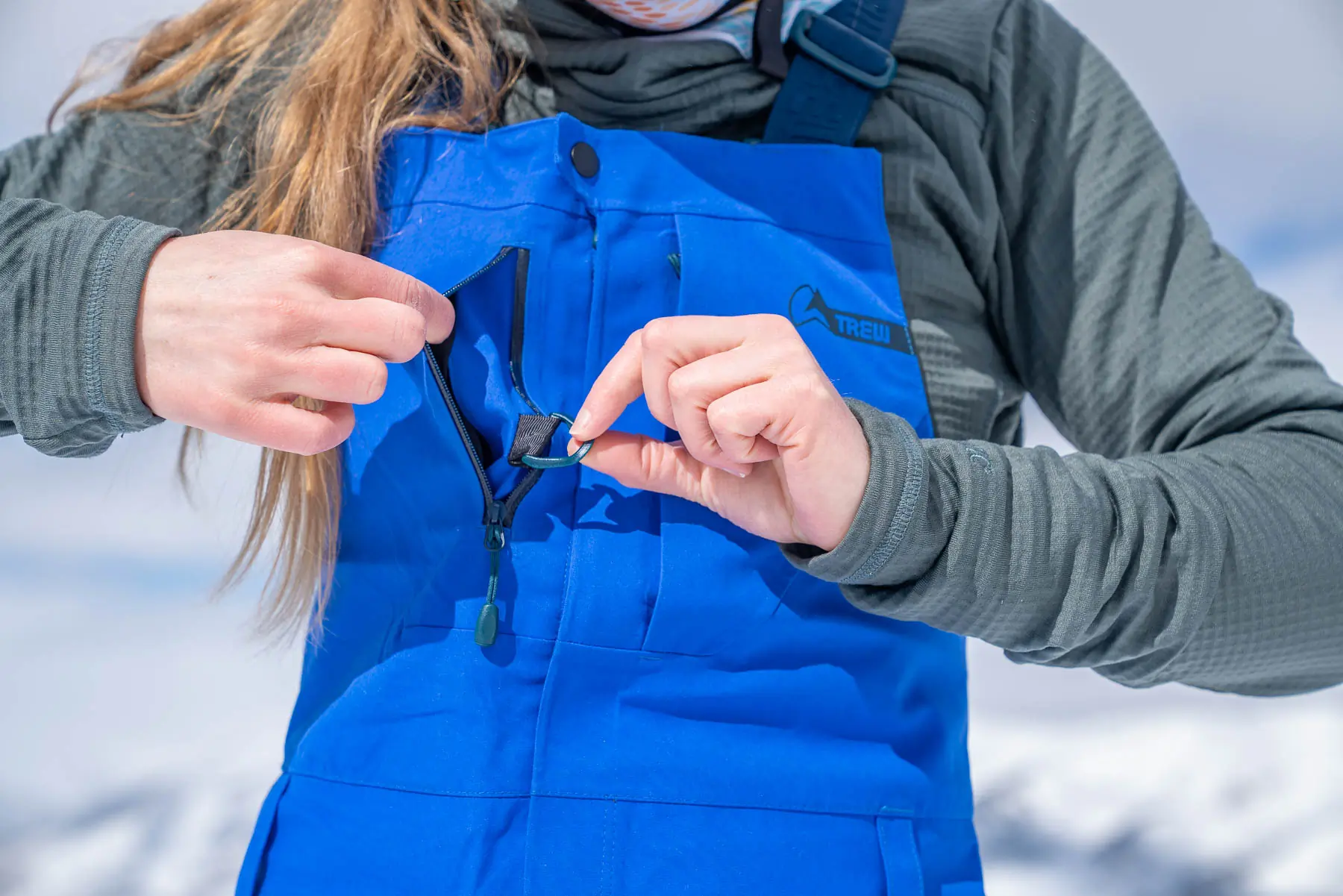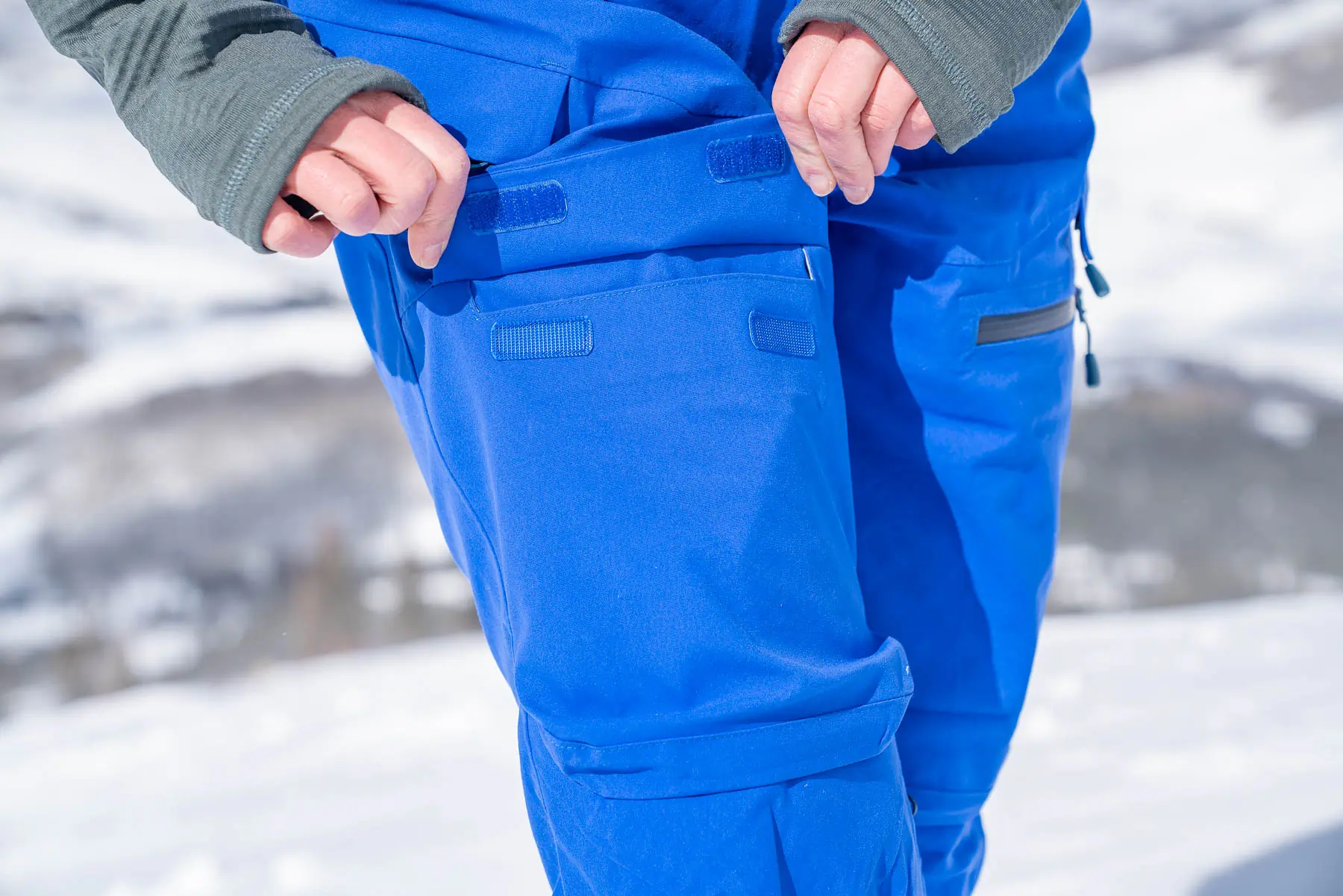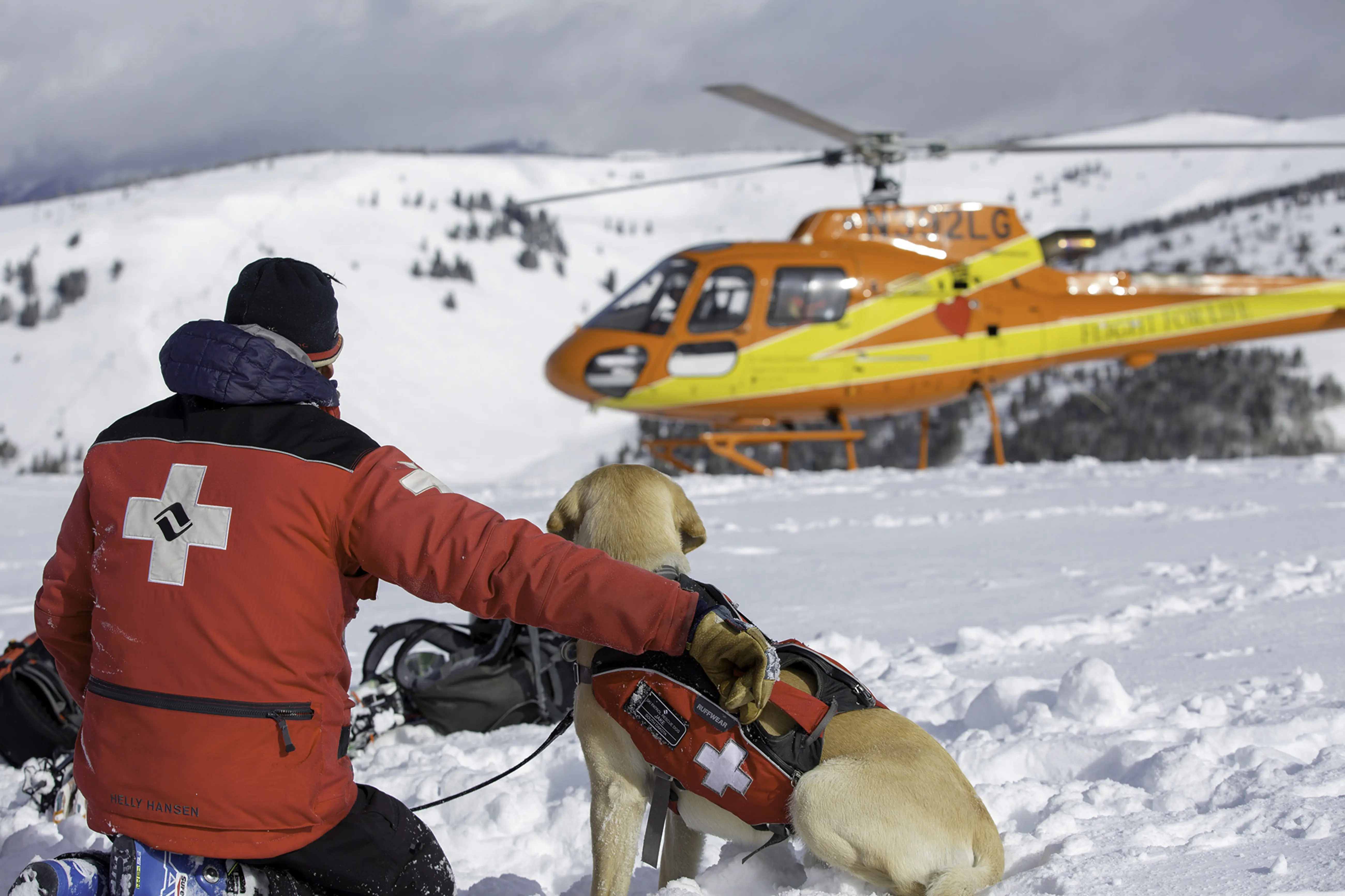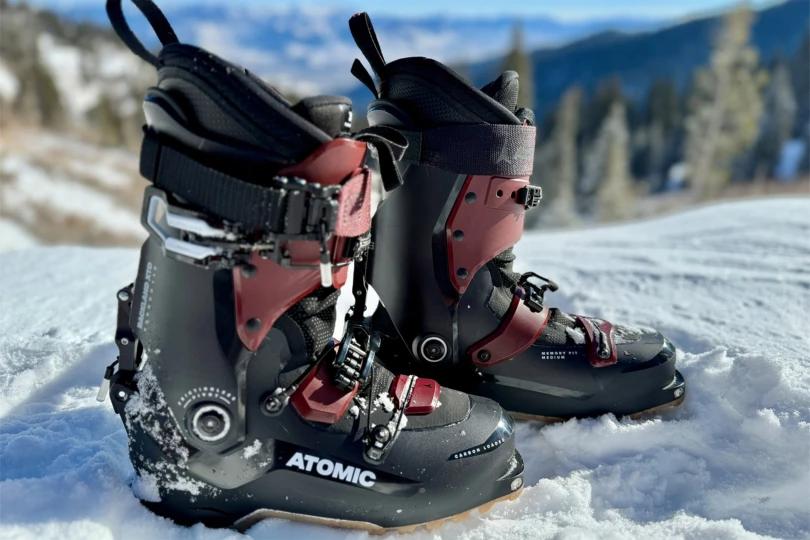A toasty torso and toes are key to a happy riding day, but don’t sleep on the importance of pants. Sure, snowboard pants are a fashion statement. But they also provide key comfort, warmth, and protection on a frozen chairlift or breathability while booting or skinning up a remote mountainside.
The best designs fit well without falling down or being restrictive. Athletic pairs have knees that are articulated, and the legs are well tapered like on the Jones Shralpinist Stretch Recycled Pants. The hems need to be wide enough to seamlessly slide over the broad neck of snowboard boots, especially for boot adjustments midday. Some pants, including the Burton Cargo Pants, deliver basic 2-layer, 10K protection against occasional snowfall, which can be plenty of protection in milder winter climates.
Depending on your shred zone and the performance you need, there’s a wide range of snowboard pants for the frontcountry and backcountry that can check the boxes.
Editor’s Note: We updated our Snowboard Pants buyer’s guide on October 28, 2025, with the field-tested Patagonia PowSlayer Pants. We also added an extended rating system that includes Weather Protection, Fit and Mobility, Durability and Construction Quality, plus Breathability and Ventilation. Read about it in our Snowboard Pants Rating System.
Read more of our favorite field-tested fits in our Best Snowboard Pants for Men roundup.
The Best Snowboard Pants of 2025-2026
Volcom L GORE-TEX Pants
-
Weather Protection
9.0
-
Fit and Mobility
9.0
-
Durability and Construction Quality
9.0
-
Breathability and Ventilation
8.5
- Fit: Relaxed fit with articulated knees
- Material: Nylon with 2-layer GORE-TEX
- Waterproof rating (mm): 28,000
- Breathability (g): 20,000
- Insulation: None
- Sustainable features: Bluesign-approved nylon + PFC-free laminate shell
Pros
- Reinforced in high-wear areas
- High-quality waterproofing
- Nice looking
Cons
- Some riders find them to be excessively baggy
Volcom Aston GORE-TEX Pants
-
Weather Protection
9.0
-
Fit and Mobility
9.0
-
Durability and Construction Quality
9.0
-
Breathability and Ventilation
8.5
- Fit: Stretch slim
- Material: GORE-TEX 2-layer stretch
- Waterproof rating (mm): 28,000
- Breathability (g): 20,000
- Insulation: None
- Sustainable features: None
Pros
- Zippers for ventilation
- Fully taped seams
- Belt loops
Cons
- No eco-friendly traits
Burton Cargo Snow Pants
-
Weather Protection
5.0
-
Fit and Mobility
7.0
-
Durability and Construction Quality
7.0
-
Breathability and Ventilation
5.0
- Fit: Regular
- Material: Polyester twill weave with 2-layer DryRide membrane
- Waterproof rating (mm): 10,000
- Breathability (g): 10,000
- Insulation: None
- Sustainable features: Bluesign-approved
Pros
- Good value
- Nice balance of warmth and breathability
Cons
- Not super roomy in the crotch area
- May be a bit short for riders over 6′
Burton Women’s Reserve Stretch Slim Pants
-
Weather Protection
8.5
-
Fit and Mobility
9.0
-
Durability and Construction Quality
8.0
-
Breathability and Ventilation
8.5
- Fit: Athletic, slim fit
- Material: 2-layer fabric with CO DWR finish
- Waterproof rating (mm): 20,000
- Breathability (g): 20,000
- Insulation: None
- Sustainable features: Bluesign-approved, PFC-free CO DWR finish, Certified B Corporation
Pros
- Slim fit is stylish and bulk-free
- Softly lined hand pockets
- Zipper at hem expands cuff over boots
Cons
- No GORE-TEX waterproofing if that's a necessity
- Lacks insulation
The North Face Freedom Insulated Pants
-
Weather Protection
6.0
-
Fit and Mobility
7.5
-
Durability and Construction Quality
7.5
-
Breathability and Ventilation
6.0
- Fit: Slim
- Material: Nylon blend with 2-layer DryVent construction
- Waterproof rating (mm): Unknown
- Breathability (g): Unknown
- Insulation: Synthetic
- Sustainable features: Heatseeker insulation is made from 50% post-consumer recycled material
Pros
- Excellent value
- Ideal for cold conditions
Cons
- Not the most breathable
686 Aura Insulated Cargo Pants
-
Weather Protection
6.5
-
Fit and Mobility
7.5
-
Durability and Construction Quality
7.5
-
Breathability and Ventilation
6.0
- Fit: Baggy
- Material: 2-layer infiDRY 10K fabric with PFAS-free DWR
- Waterproof rating (mm): 10K
- Breathability (g): 10K
- Insulation: 40 g lightweight infiLOFT body-mapped in backside and knees
- Sustainable features: B Corp Certification, meeting community standards from employee benefits to supply chain and material selection
Pros
- Baggy yet feminine shape for ultimate comfort and aesthetic
- So many pockets!
- Lightly, strategically insulated with interior leg vents is the perfect combo
- Excellent price
Cons
- Internal hang loop is small and inflexible, making it hard to hang dry pants off larger hooks
- Hand pockets have fleece liner above digits — we’d like that material on the hand’s underside
- 10K waterproofing might not provide long-term or enough protection for heavy coastal storms
Patagonia Women’s PowSlayer Pants
-
Weather Protection
8.9
-
Fit and Mobility
9.0
-
Durability and Construction Quality
9.0
-
Breathability and Ventilation
9.0
- Fit: Relaxed
- Material: GORE-TEX Pro ePE
- Waterproof rating (mm): Unavailable
- Breathability (g): Unavailable
- Insulation: None
- Sustainable features: Fair Trade Certified factory, GORE-TEX Pro ePE is 100% recycled nylon with a PFC-free DWR
Pros
- Large bellowed thigh pockets are roomy (and fit a large phone)
- Robust reinforced hems
- Supremely articulated fabric around hips and glutes for freedom of movement
- Feels very lightweight
Cons
- Hard to keep stains out of the light colored fabric
- Expensive
- Light-feeling fabric does not block cold wind well — wear a heavier base layer on blustery days
Other Steezy Snowboard Pants We Recommend
-
Weather Protection
8.5
-
Fit and Mobility
8.5
-
Durability and Construction Quality
7.5
-
Breathability and Ventilation
6.0
- Fit: Regular
- Material: 100% circular polyester, PFC-free DWR, Coremax tricot lining
- Waterproof rating (mm): 20K
- Breathability (g): 20K
- Insulation: Yes — recycled thermal STD 40 gsm insulation
- Sustainable features: Upcycled/recycled fabric, PFC-free surface treatment, recycled insulation
Pros
- Insulation provides comfort on below freezing days
- Innovative cinch for hem stowaway (accessed via hand pockets)
- Roomy and stylish
- Circular polyester's upcycled fabrics avoid landfill
Cons
- At 770 g, the pants feel a tad heavier than other pairs
- Insulation could be too much on super sunny, warm spring days
- High-reaching waistband might not be everyone’s choice style
-
Weather Protection
9.8
-
Fit and Mobility
8.0
-
Durability and Construction Quality
9.0
-
Breathability and Ventilation
9.5
- Fit: Relaxed
- Material: 3-layer 100% recycled 70-denier polyester fabric, 100% 20-denier recycled polyester backer, PFC-free DWR
- Waterproof rating (mm): 30,000
- Breathability (g): 30,000
- Insulation: None
- Sustainable features: 100% recycled materials, OEKO-TEX Standard 100 certified, WRAP certified factories, BSCI certified factories
Pros
- RECCO
- 3 pockets
- Buttery soft and breathable fabric
Cons
- Zipper teeth on pockets are rough against hands
- Interior mesh pockets are difficult to slide large phone past
-
Weather Protection
8.5
-
Fit and Mobility
9.0
-
Durability and Construction Quality
8.0
-
Breathability and Ventilation
8.5
- Fit: Relaxed
- Material: 4-way stretch recycled polyester with PFC-free DWR and 3L plain weave ultralight backer
- Waterproof rating (mm): 20,000
- Breathability (g): 20,000
- Insulation: None
- Sustainable features: 100% recycled and recyclable fabric
Pros
- RECCO
- Fully taped seams
- Integrated belt loops
Cons
- Thigh pockets could be a tad larger
- Pricer option
-
Weather Protection
6.0
-
Fit and Mobility
6.0
-
Durability and Construction Quality
6.5
-
Breathability and Ventilation
5.0
- Fit: Very fitted
- Material: 56% polyester, 32% recycled polyester, 12% elastane
- Waterproof rating (mm): 15,000
- Breathability (g): 10,000
- Insulation: None
- Sustainable features: PFC-free DWR treatment, recycled polyester blend
Pros
- High-reaching neoprene waist panel
- Belt loops
Cons
- Pockets are small and not ergonomic or utility-focused
- Too lean-fitting for some ladies
-
Weather Protection
5.0
-
Fit and Mobility
7.5
-
Durability and Construction Quality
7.5
-
Breathability and Ventilation
5.0
- Fit: Relaxed / baggy
- Material: 45% nylon, 55% cotton
- Waterproof rating (mm): 10,000
- Breathability (g): 10,000
- Insulation: None
- Sustainable features: None
Pros
- 90’s inspired throwback design style
- Unisex design
- Offers jacket – pant connection
Cons
- Go easy on the fabric in tight trees – they tear easily
-
Weather Protection
8.5
-
Fit and Mobility
8.9
-
Durability and Construction Quality
9.0
-
Breathability and Ventilation
8.5
- Fit: Semi-loose
- Material: PNW 3L Primo Fabric woven with 100% recycled nylon
- Waterproof rating (mm): 20,000
- Breathability (g): 20,000
- Insulation: None
- Sustainable features: 100% recycled nylon, Bluesign certified
Pros
- Heavy-duty and waterproof
- Rugged Durability
- Extended sizes
Cons
- Small chest pockets for phones
-
Weather Protection
8.5
-
Fit and Mobility
8.0
-
Durability and Construction Quality
9.0
-
Breathability and Ventilation
8.5
- Fit: Slim-fitting with a range of movement
- Material: PNW-level 3L Primo Fabric woven with 100% recycled nylon, Bluesign certified
- Waterproof rating (mm): 20,000mm
- Breathability (g): 20,000
- Insulation: No
- Sustainable features: 100% recycled nylon, Bluesign certified
Pros
- Plenty of pockets
- 270-degree dropseat
- Sustainable proprietary textile that’s 100% recycled and very waterproof
- Jacquard elastic suspenders with silicon gripper
Cons
- A bit short for longer torsos, consider sizing up
Snowboard Pants Comparison Chart
Scroll right to view all of the columns: Price, Fit, Material, Waterproof Rating, Breathability, Insulation.
| Snowboard Pants | Price | Fit | Material | Waterproof Rating (mm) | Breathability (g) | Insulation |
|---|---|---|---|---|---|---|
| M – Volcom L | $295 | Relaxed | Nylon with 2-layer GORE-TEX | 28,000 | 20,000 | No |
| W – Volcom Aston GORE-TEX | $320 | Regular | GORE-TEX 2-layer stretch | 28,000 | 20,000 | No |
| M – The North Face Freedom Insulated | $220 | Regular | Nylon blend with 2-layer DryVent | Unavailable | Unavailable | Yes |
| M – Burton Cargo | $185 | Regular | Polyester twill weave with 2-layer DryRide | 10,000 | 10,000 | No |
| W — Burton Reserve Stretch Slim | $210 | Tailored | 2-layer fabric with CO DWR finish | 20,000 | 20,000 | No |
| Patagonia Women’s PowSlayer | $649 | Relaxed | GORE-TEX Pro ePE | Unavailable | Unavailable | No |
| L1 Premium Goods Axial | $369 | Baggy | 3-layer 87% recycled polyester, 13% spandex, PFC-free DWR | 20,000 | 20,000 | No |
| W – Picture Exa | $230 | Regular | 100% circular polyester, PFC-free DWR, Coremax tricot lining | 20,000 | 20,000 | Yes — recycled thermal STD 40 gsm insulation |
| M & W – Dakine Sender Stretch 3L | $475 | Relaxed | 4-way stretch recycled polyester with PFC-free DWR and 3L plain weave ultralight backer | 20,000 | 20,000 | No |
| W – 686 Aura Insulated Cargo | $190 | Baggy | 2-layer infiDRY 10K fabric with PFAS-free DWR | 10,000 | 10,000 | 40 g lightweight infiLOFT body-mapped in backside and knees |
| Jones Shralpinist Stretch 3L | $400 | Relaxed | 3-layer 100% recycled 40-denier polyester fabric, 100% 20-denier recycled polyester backer, and PFC-free DWR | 30,000 | 30,000 | No |
| W – Roxy Rising High | $210 | Tailored | 56% polyester, 32% recycled polyester, 12% elastane | 15,000 | 10,000 | No |
| M – Dakine A-1 | $225 | Baggy | 45% nylon, 55% cotton | 10,000 | 10,000 | No |
| M – TREW TREWth PRIMO Bib | $519 | Relaxed | PNW 3L Primo Fabric woven with 100% recycled nylon | 20,000 | 20,000 | No |
| W –TREW PRIMO Chariot Bib | $499 | Tailored | PNW-level 3L Primo Fabric woven with 100% recycled nylon, Bluesign certified | 20,000 | 20,000 | No |
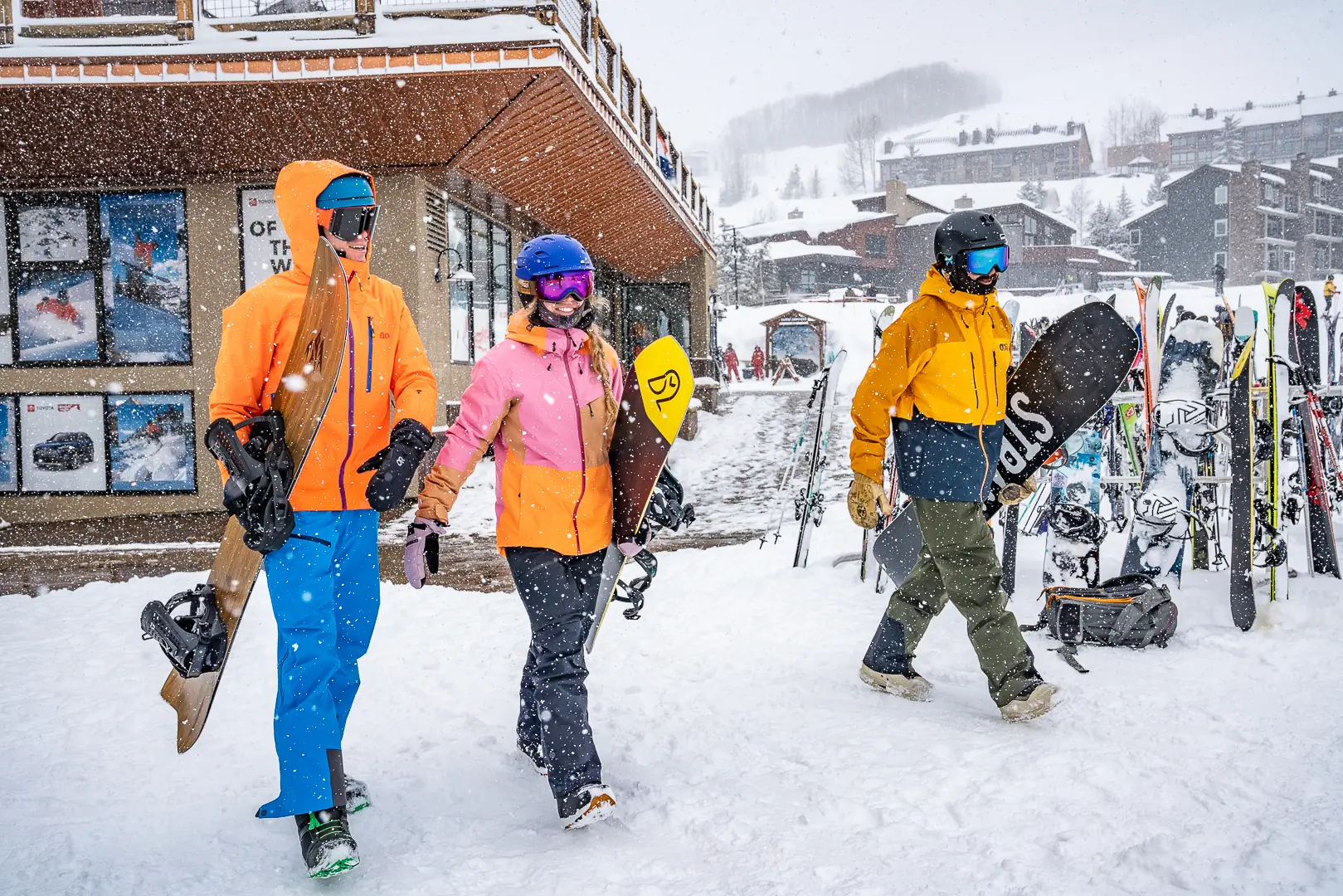
How We Tested the Best Snowboard Pants
Our GearJunkie snowboard gear testers include expert riders, splitboarders, and certified instructors.
Our Expert Testers
Leading the gear testing, snow sports Senior Editor Morgan Tilton has been snowboarding since 2002, when she switched from two planks to one, which she started at age 4 on the steeps of Telluride Ski Resort in her hometown. Over the years, she’s competed in Slopestyle comps, backcountry tours, pow surfs, and still pulls on skis. While she coordinates field testers, she gets out in the field as much as possible. She tested snowboard pants for 104 hours across 34 days in 2023. In 2024, she tested snowboard pants for 155 hours across 45 days. So far in 2025, she has tested snowboard pants for 48 hours, 198 miles, and nearly 50,000 vertical feet on snow. She also tests ski bibs.
Contributing photographer and tester Eric Phillips is a formerly certified Level II PSIA-AASI instructor and big mountain pow surfer when he’s not at the resort or on splitboard tours.
Other contributors include Wyoming-based Austin Beck-Doss and Crested Butte-based shredder Will Martinez.
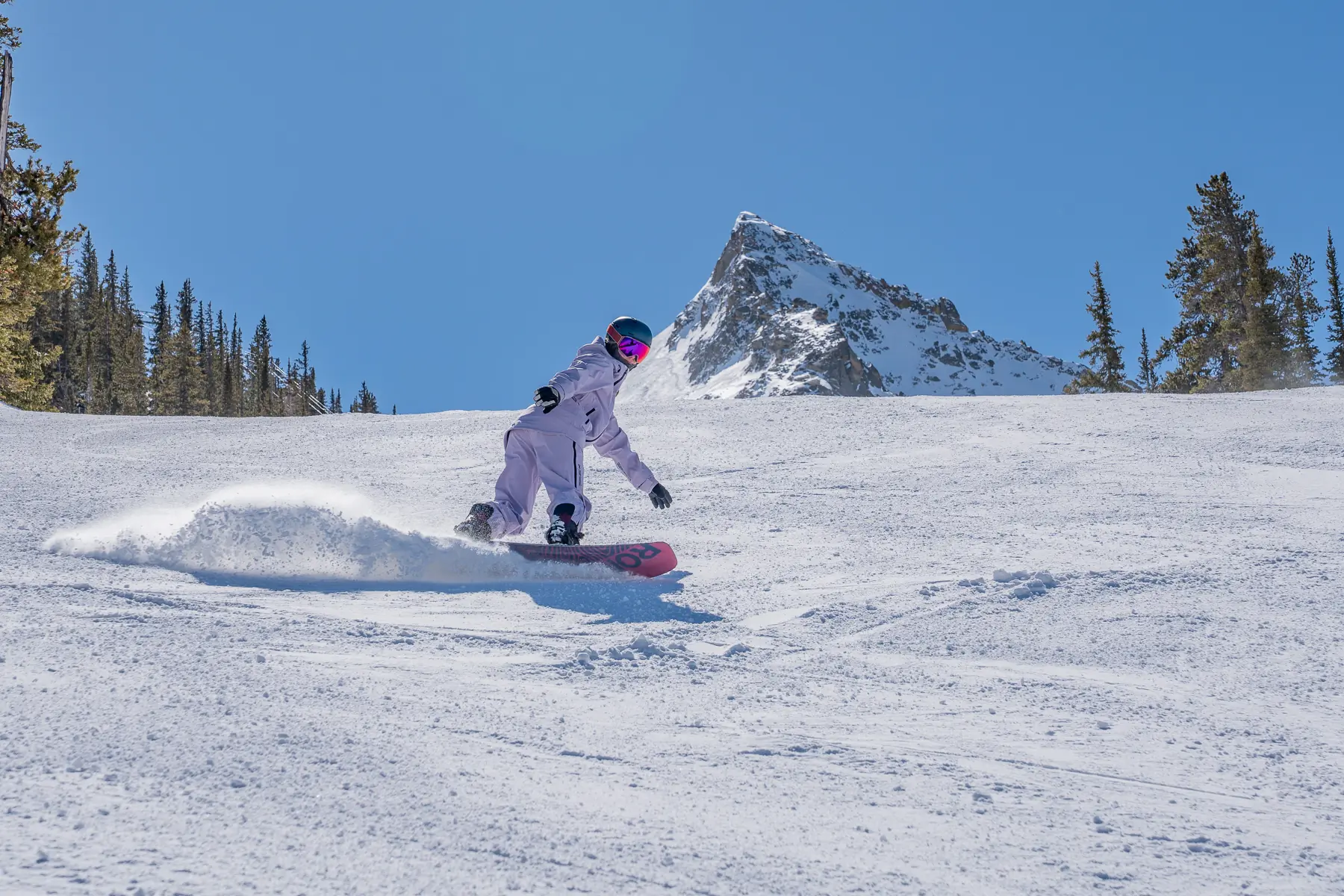



Our Testing Grounds
We’ve tested snowboard pants in a range of conditions from California to the Colorado Rockies and high-alpine environments, as well as British Columbia. Our apparel has protected us in ice-cold wind, on long lift rides, across backcountry tours, and while romping through deep powder.
The GearJunkie team meets for an annual on-snow test week to grind out turns and swap notes, including two previous gatherings at Crested Butte Mountain Resort, which is known for its expert terrain.
Our Testing Process
While testing snowboard pants we consider overall fit, function, durability, vents, gaiters, boot compatibility, waistband, belt loops, ease of movement, pockets, cuff reinforcement, weather protection — including precipitation, cold temps, and wind — style, sustainability, and value.
We also take into consideration the most novel, popular, highly rated, and legacy products across a range of price points.
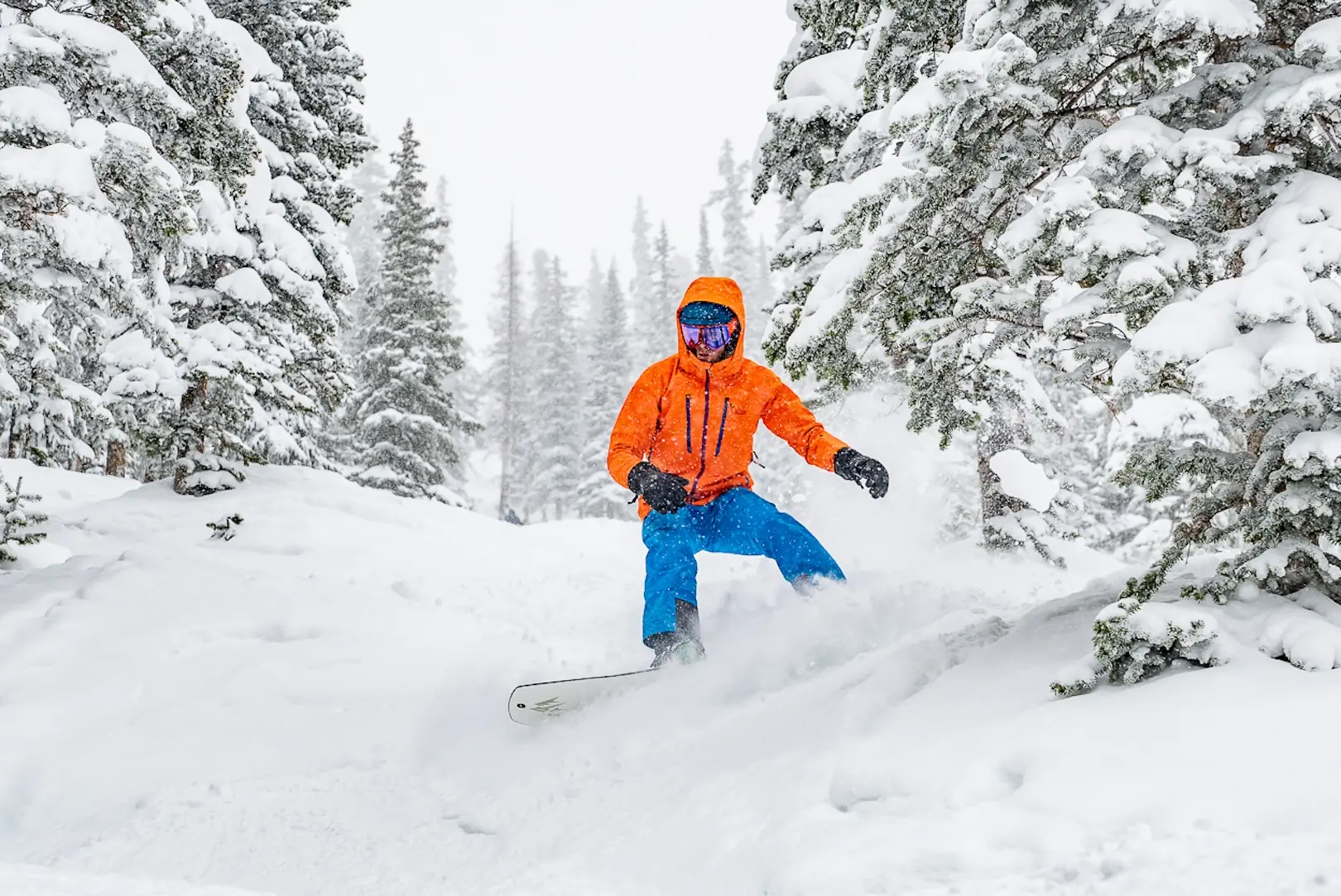



Our Snowboard Pants Rating System
We score each pair of snowboard pants on a 1–10 scale for Weather Protection, Fit and Mobility, Durability and Construction Quality, plus Breathability and Ventilation.
While considering weather protection, we take into account how the pants shield moisture and wind. Fit and mobility examines how effortlessly the pants move with us while going uphill, downhill, sitting, and bending over, as well as if there are any snag points. Durability and construction quality considers the overall material, stitching, hems, waistband, zippers, cuffs (plus the ease of sliding them over our snowboard boots), and pockets. The breathability and ventilation takes a look at how effectively the design releases moisture and heat during high-output activity, including the material and mechanical vents.
The Overall Rating is based on contextual, editorial judgment, and the complex user experience across various scenarios and conditions.




Buyer’s Guide: How to Choose Snowboard Pants
Every rider needs a reliable pair of snowboard pants. Sure, you can technically ride in just about any kind of pants, but the comfort and waterproofing that comes with a high-quality purpose-built pair are unmatched.
With so many great options to choose from, it can be difficult to select a single pair of snowboard pants. Between materials, features, and price, there are quite a few factors to consider when navigating the snowboard pants market. In this handy how-to-choose guide, we’ve compiled all of the information you need to make an informed purchase.


How Snowboard Pants Differ From Ski Pants
While ski pants and snowboard pants are similar, there are some key differentiators within the functionality of snowboard pants and the style. While some riders find snowboard-specific pants come with certain advantages, others are perfectly happy using generalized snow pants that work for both skiing and snowboarding.
The key: Be sure the snow pant cuff is wide enough or expandable to fit over snowboard boots, which vary in size. Some boots have a wider circumference than others due to size, inserts, an integrated BOA, dense material, or being a larger size. Many ski pants have a cuff that is too narrow to quickly and easily slide over snowboard boots, while others are unable to fit over snowboard boots at all. Cuffs on snowboard pants are often adjustable and can expand via sturdy snaps or zippers or stretchy material.
Snowboard-specific pants also usually fit on the baggier side to allow for plenty of flexibility in a crouched position and for a wide stance. Snowboarding involves a lot of dynamic lower-body movement — especially in the terrain park. If maximum flexibility is a concern, we recommend seeking out a slightly baggy snowboard-specific pant.
Because snowboarders tend to spend more time sitting down on the snow than skiers, some snowboard pants also come with fabric reinforcement in the rear.
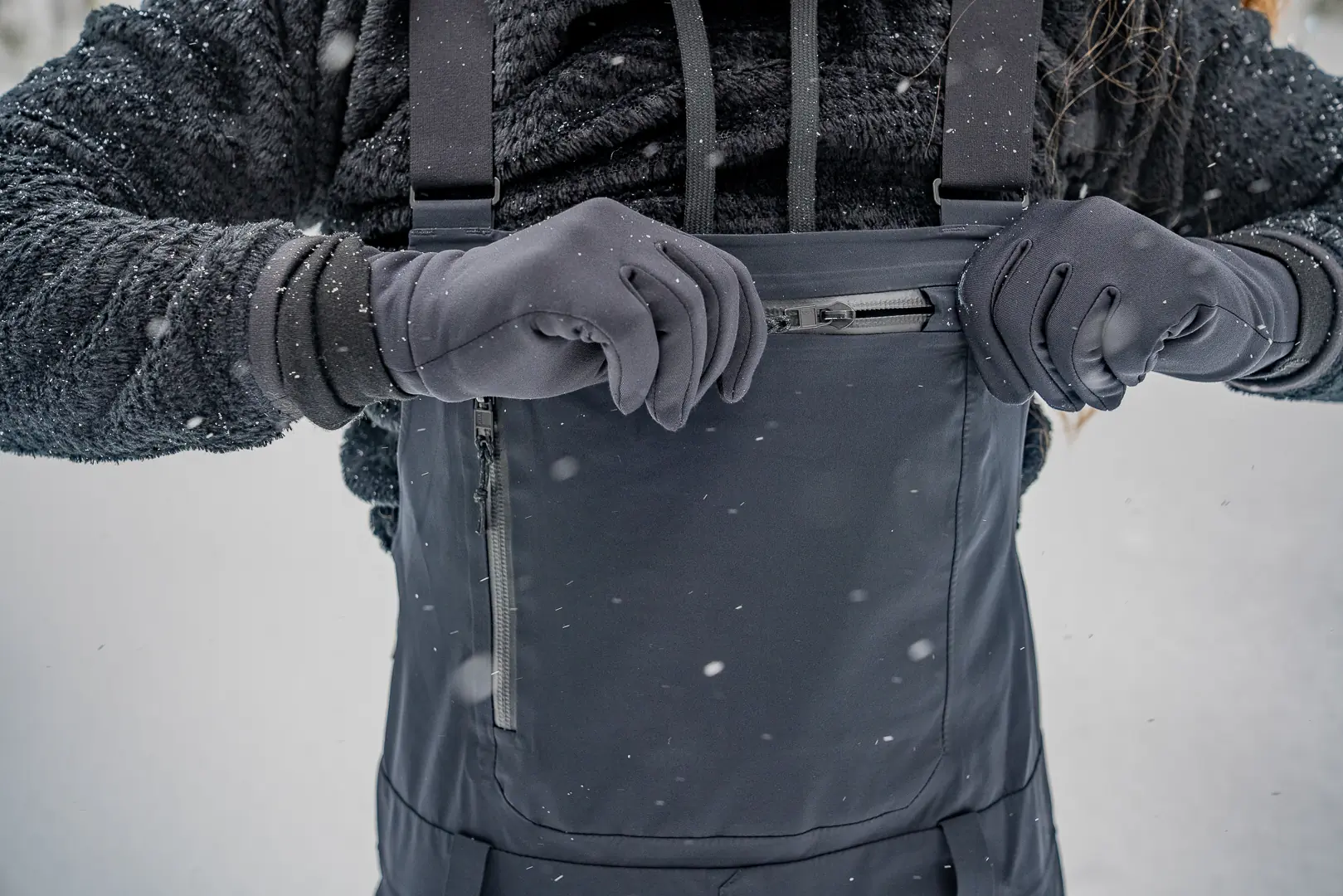



Snowboard Bibs vs. Snowboard Pants
The choice between snowboard pants and snow bibs comes down to a combination of personal preference and function. Bibs are suspended by shoulder straps and are generally more effective at keeping snow out. Pants are held up by the waistband and offer less insulation because there is less material.
On deep powder days, a bib can be a game-changing addition to your kit. For this reason, we specifically recommend bibs to those who regularly ride in areas with lots of snowfall. Backcountry riders also tend to enjoy the extra coverage and protection provided by bibs.
Bibs always make going to the bathroom so much easier. Many bibs come with a drop seat, which is essentially a flap that opens in the back. Drop seats are handy when you need to squat and go in the backcountry as well as when you want to stay layered up in an indoor bathroom at the ski lodge.
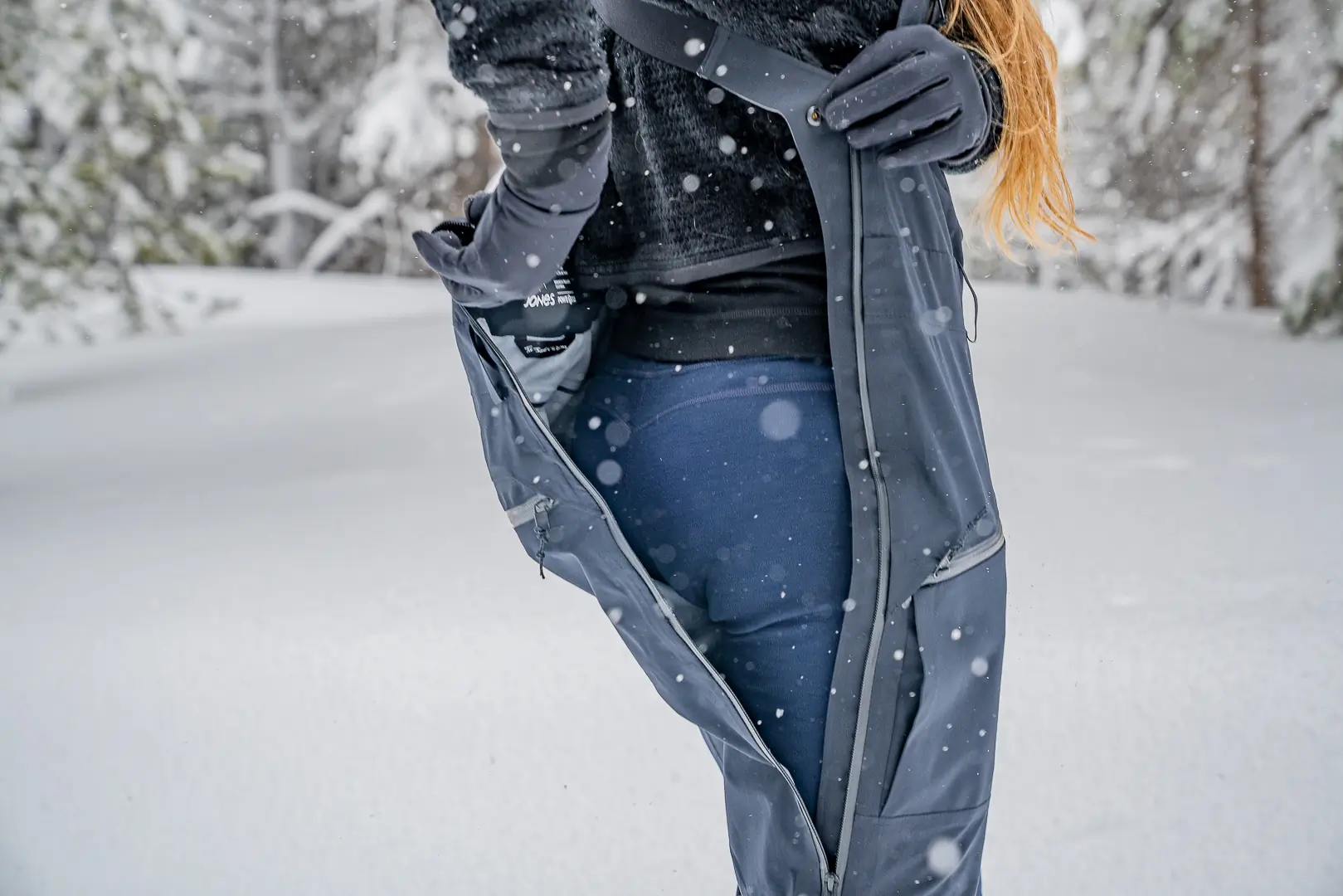



Resort Riding vs. Backcountry Splitboarding
If you plan to regularly snowboard in the backcountry, you’ll want pants or bibs that are up to the task. Riding in the backcountry means hiking uphill, and there are a few key features that can make the experience much more enjoyable.
First, backcountry riders need breathable outerwear plus an avalanche beacon and ski pack. When hiking, you will generate heat, which can quickly lead to perspiration. Sweating in the backcountry is not ideal, since the moisture quickly becomes cold and uncomfortable as soon as the hike is over.
For this reason, we recommend seeking breathable materials and well-designed vents. For backcountry snowboarding, insulated pants are generally not recommended.
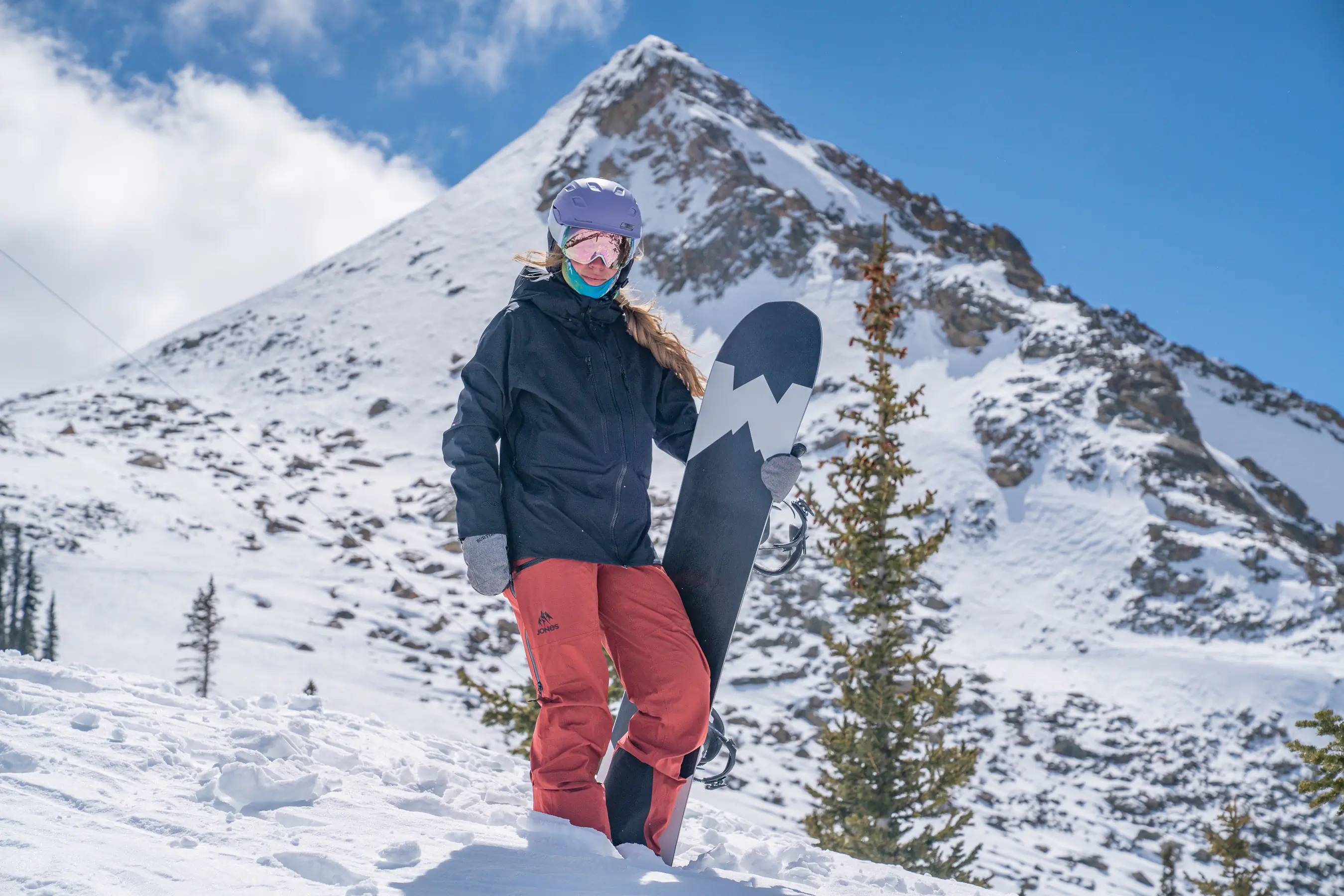



Additionally, backcountry snowboard pants should have reinforced fabric around the inner ankle and calf. While skinning or climbing uphill, the interior pant can be exposed to the sharp edge of the opposing split-ski or crampons, which can lead to tears if your pants have not been properly designed for the job. Riding a backcountry snowmobile for access can also lead to beat-up cuffs, especially if they aren’t reinforced.
If you do a lot of in-bounds boot packing or uphill hiking, consider a pair with reinforced fabric around the inner ankle, too. Boot packing at the resort can also lead to interior scuffs from your snowboard boots. Even when we’re skating through the lift line at the resort or connecting runs via flat meadows or groomed corduroy, it’s easy to beat up the interior pant legs with a board’s metal edge.
Resort riding is generally less demanding on your outerwear. Because the bathrooms and lodge are always relatively close by, you don’t have to worry as much about bathroom breaks or temperature control.
Most resort riders prefer a relatively simple pair of traditional snowboard pants.


Materials & Durability
Snowboard pants need to be durable enough to hold up to the demands of shredding through the trees and ripping deep carves. On this list, we’ve recommended many high-quality pairs of snowboard pants, but some are more durable than others.
Most ski pants are primarily made of nylon, polyester, or a blend of both. Many styles are reinforced in key wear areas to prevent premature material failure.
If durability is a primary concern, be sure to find a pair of pants with two-layer or three-layer fabric construction. Burly zippers and fully taped seams are also a plus.
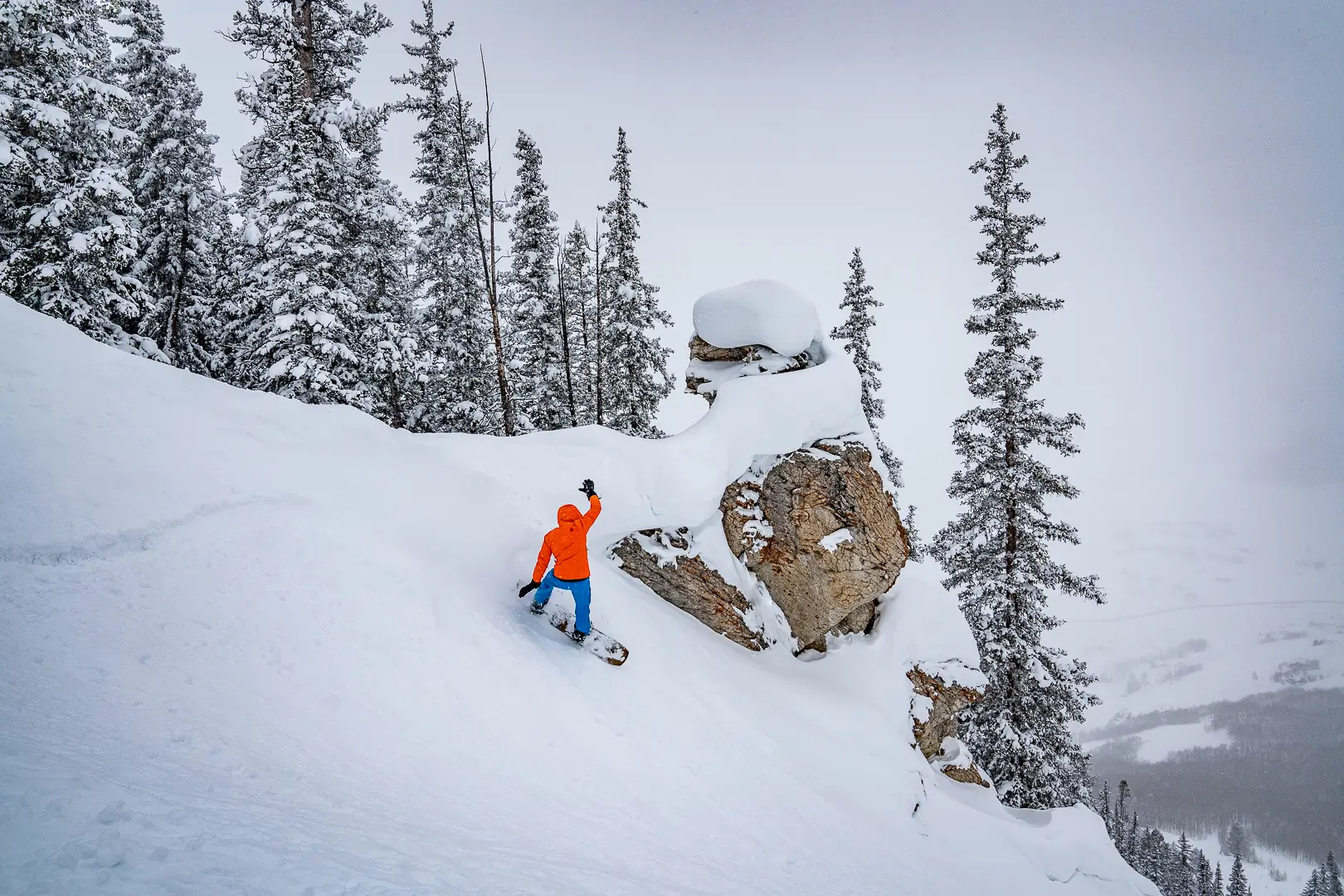



Insulation & Warmth
Most snowboard pants on the market are not insulated. The primary job of snowboard pants is to keep you dry and protect your body from the surrounding weather. Because most snowboard pants are in the shell category, most riders wear various base layers underneath to keep their legs warm and comfortable. Base layers range in thickness and the amount of warmth they provide, thanks to a variety of fibers.
However, if you tend to run cold or regularly ride in extra cold conditions, you may want to purchase snowboard pants with built-in insulation. Some styles come with insulation strategically located only in key cold-prone areas.
On this list, we have included insulated and uninsulated snowboard pants.
Below are the insulated pants in our guide:
- The North Face Freedom Insulated Pants – 60g synthetic
In general, 60g of synthetic insulation is best for cold to extremely cold conditions or around 15 degrees to -15 degrees.
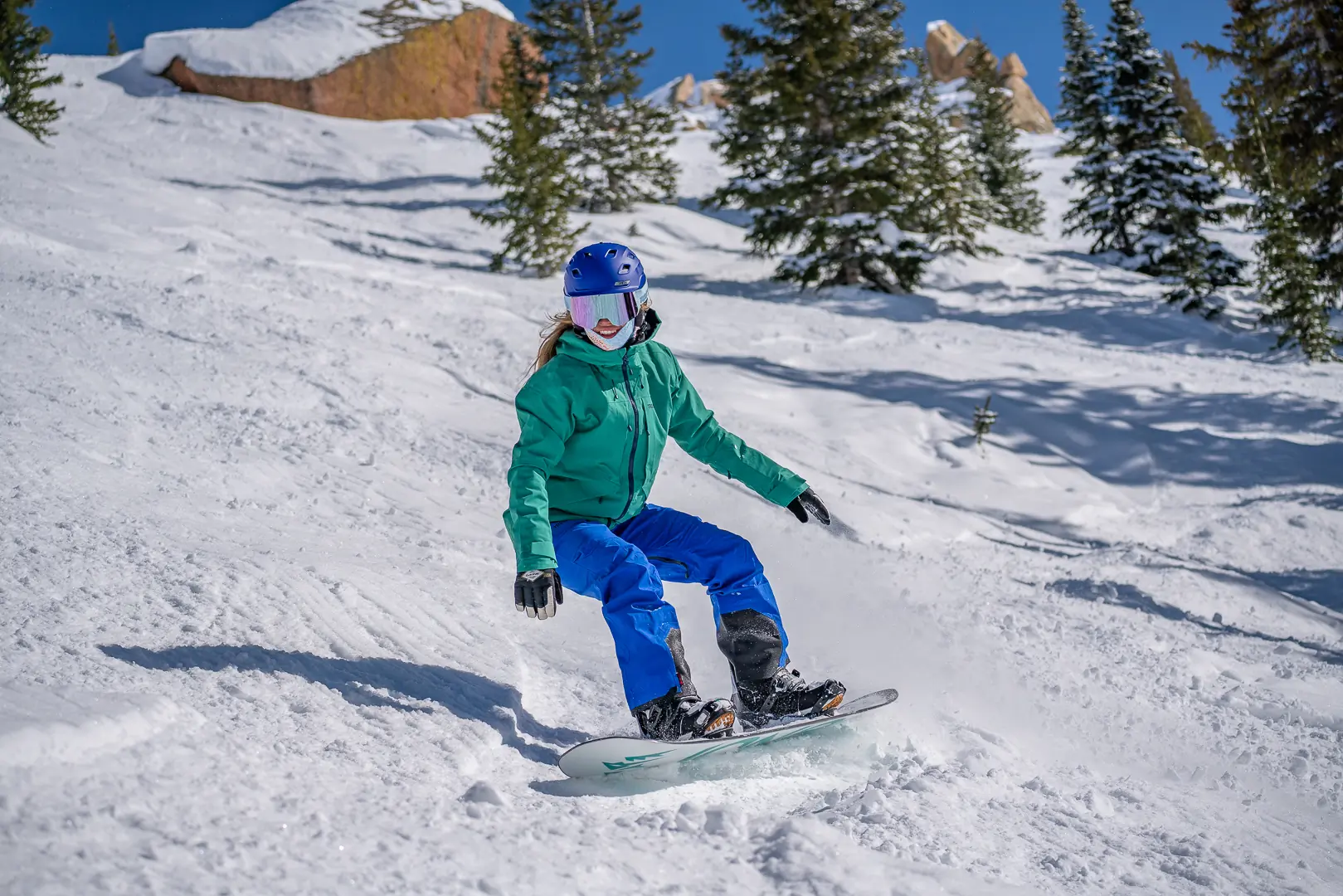



Waterproofing & Breathability
While wearing snowboard pants, you’ll likely sit on wet surfaces and ride through falling snow or rain, depending on the climate. Reliable water resistance is an absolute must. Many of the styles included on this list come with high-end waterproof membranes and outer fabrics.
Within the outerwear industry, GORE-TEX is generally considered top-tier waterproof protection. The best well-made waterproof snowboard pants will come with taped seams, waterproof zippers, and a DWR coating.
Every snowboarder has a different comfort zone when it comes to temperature regulation and layering. For those who tend to run warm, breathable, and well-ventilated outerwear may be absolutely essential.
In general, snowboard pants will offer varying degrees of ventilation and breathability depending on their design. When backcountry riding or bootpacking, grueling uphill treks call for air-permeable outer layers.
Typically as waterproof ratings increase, the breathing of the fabric declines due to a stronger waterproof barrier moisture from the inside needs to get through to breathe. You can get high waterproof and high breathability fabrics like the Jones Shralpanist Men’s Bibs and Shralpanist Women’s Bibs.
Waterproof Levels:
- 0 – 10,000 mm: Ideal for dry – mostly dry climates like the Midwest
- 10,000 m – 20,000 mm: ideal for wet climates like the mountain west
- 20,000 mm – 30,000 mm: ideal for very wet climates like the Pacific Northwest
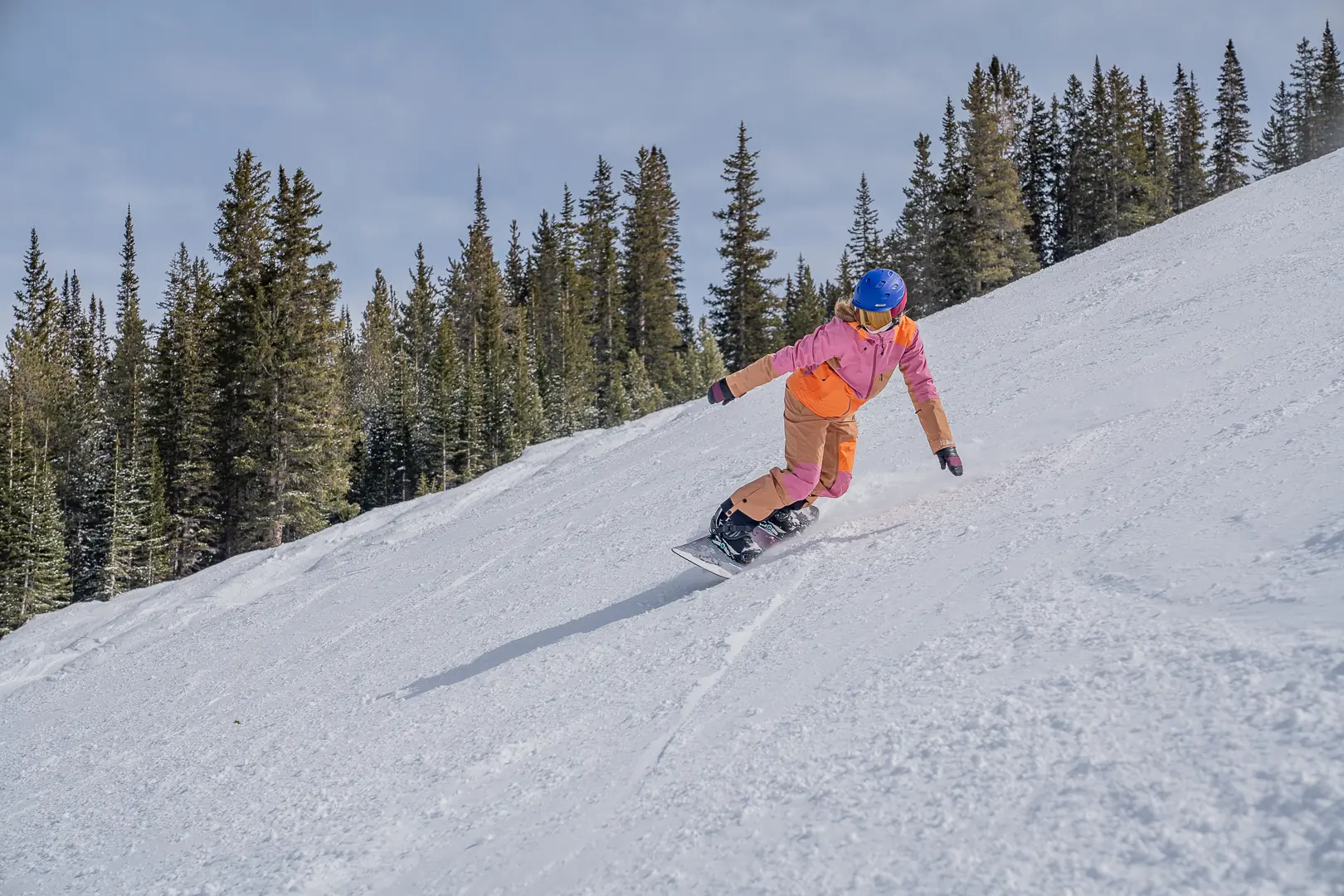



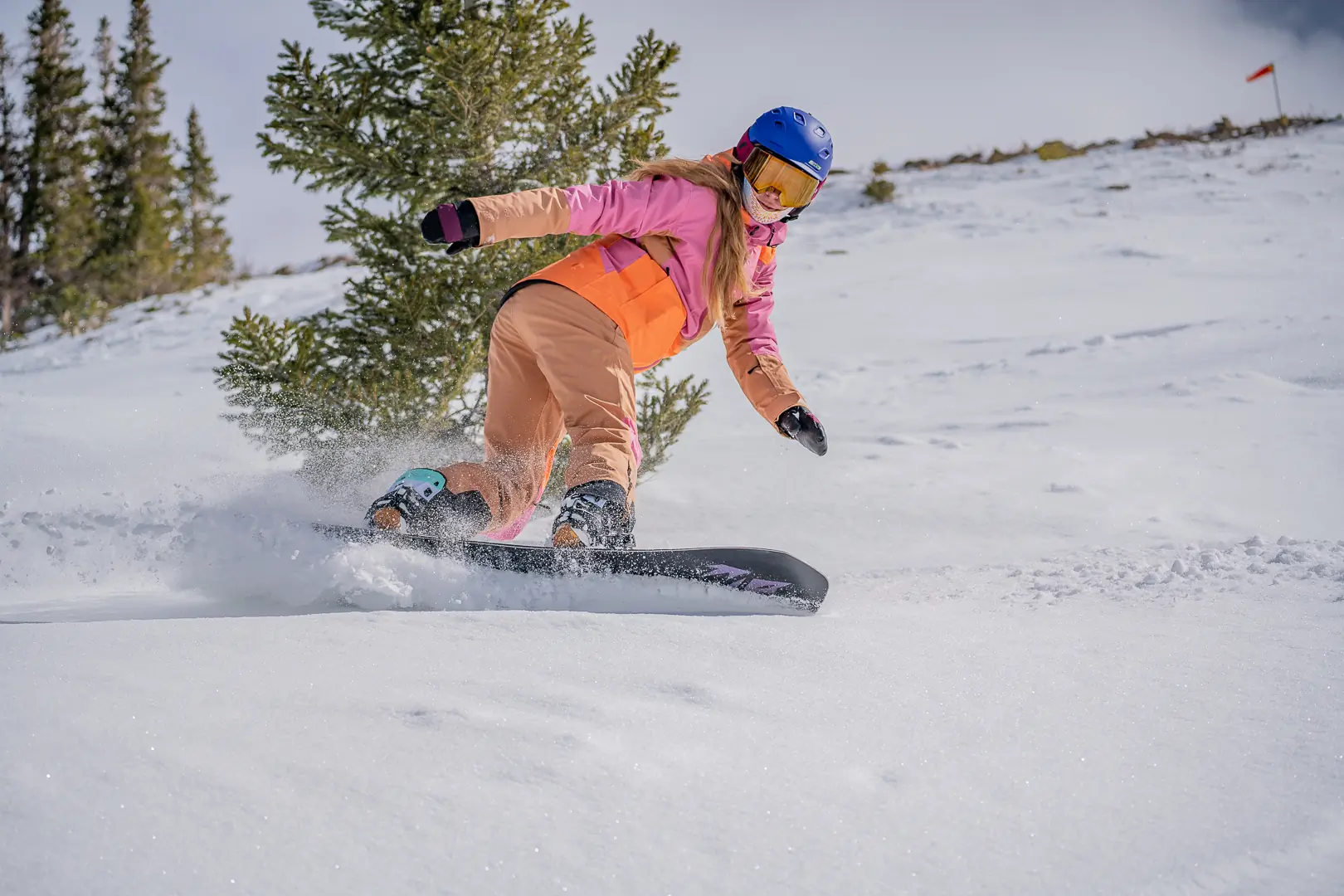



Sustainable Design
With each passing season, the snowsports outerwear industry incorporates more and more sustainable manufacturing practices and recycled materials. If sustainable features are a priority for you, be sure to check each manufacturer’s specifications for material sources, sustainable manufacturing certifications, and so on.
Jones Snowboards definitely sets the gold standard for sustainability with the brand’s recently launched apparel line for women and men. All of the Jones Outerwear materials are OEKO-TEX and/or Bluesign-certified. The majority are 100% recycled, and they utilize PFC-free DWR (except the GORE-TEX Pro fabric). Picture also makes Circular fabric, which features a portion of upcycled factory scraps mixed with reclaimed toss-outs.
Bluesign is a top-tier certification for textile products that are safe for the environment, workers, and customers. We’ve included multiple Bluesign-certified pants and bibs on this list.
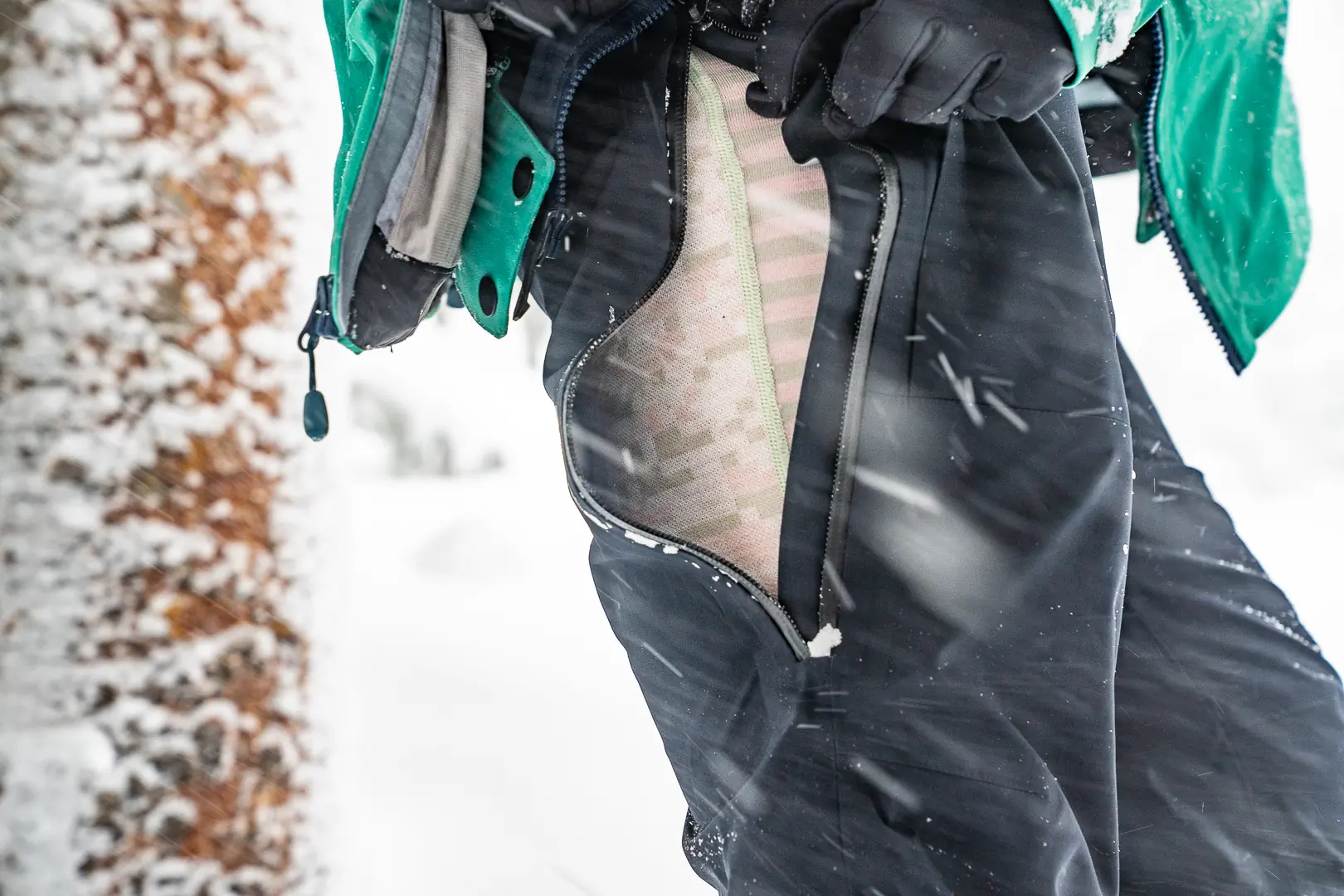



Leg Vents
Different types of fabric have varying levels of breathability in snowboard pants. You can read the breathability and waterproof ratings to get an idea of how easily the fabric breathes. The more waterproof a fabric is, generally the less breathable it is. If a pant is insulated, expect it to feel warmer.
Regardless of the insulation, breathability, and waterproofness of a pant, it’s typically a great idea to invest in a pair with ventilation if you plan to ride in the warmer spring months. Riding on powder days or in the trees can also quickly build body heat, even on midwinter days.
Ventilation is also great if you generally ride in a milder climate, don’t take cooldown breaks from top to bottom, or tend to build heat while riding. If you plan to uphill at the resort or if you explore boot-accessed hike-to terrain or backcountry splitboard, ventilation is mandatory.
Ventilation usually includes zippered openings along the interior thigh. Bibs often utilize the drop-seat zipper as a ventilation zipper on the exterior legs. It’s nice when pants have an interior mesh liner to offer some protection from snow drift (and privacy) while you ride or sit on the lift airing out your lower half. Full snowsuits usually also have ventilation below the arms.
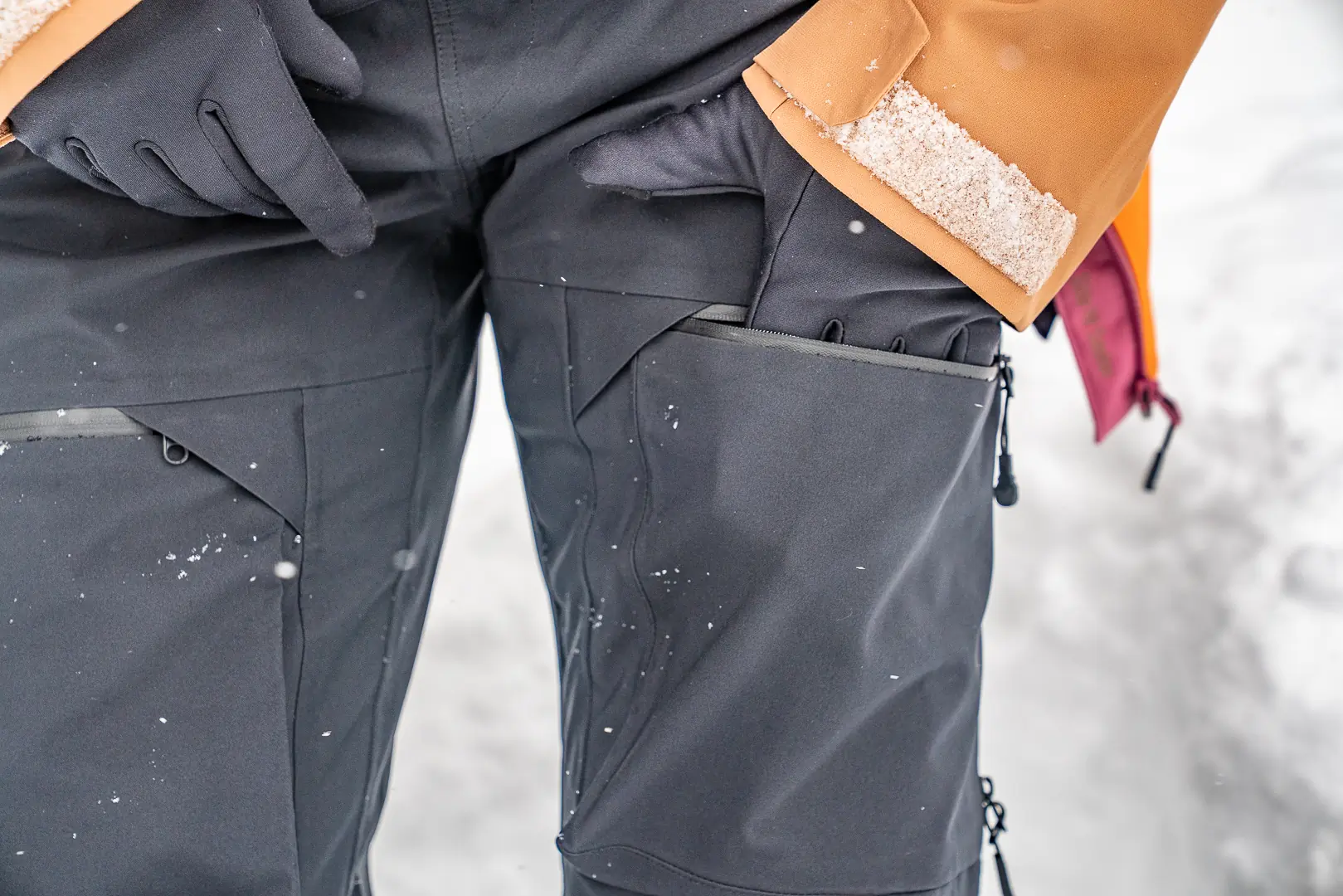



Pockets
If you prefer to carry items in your pants versus your jacket, be mindful of the pockets in the snowboard pants you choose. Some are just for looks, while others are extremely functional.
The options range from hand pockets — sometimes zippered and other times with no closure at all — to various cargo pockets on the thighs and sometimes pockets on the backside. We find the most functional pockets are either deep hand pockets that are zippered and spacious or big, well-positioned thigh pockets.
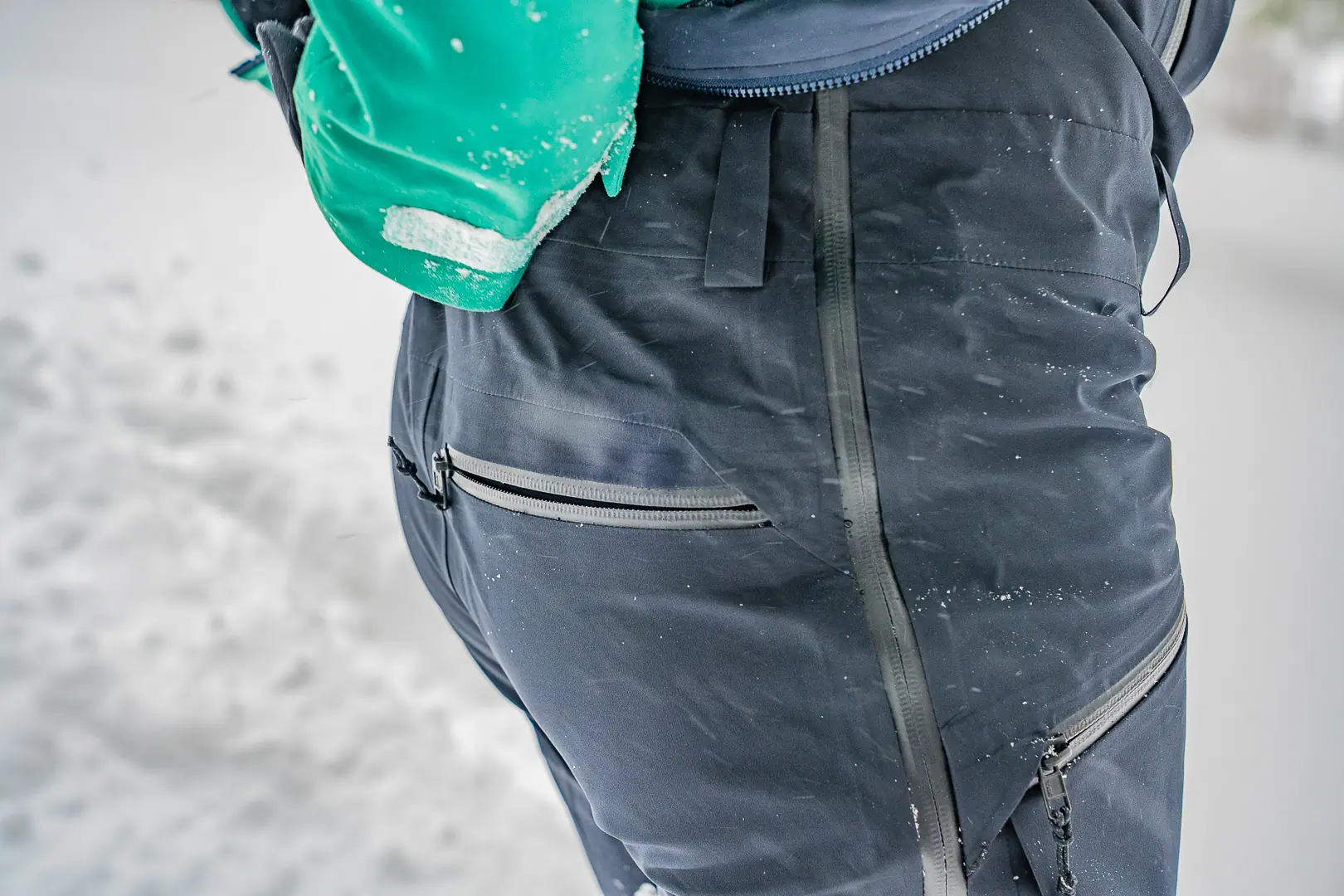



If you’re looking for bibs for backcountry exploration, it’s nice for those designs to have a thigh or chest pocket that accommodates a beacon. For some, carrying a beacon against the torso can feel more comfortable and functional than toting a beacon in a thigh pocket.
In contrast, it’s easier to grab a phone out of a leg pocket while riding or skinning in the backcountry than to unzip a jacket to access a bib’s chest pocket. The caveat — a chest pocket is generally warmer and will help preserve the battery life.
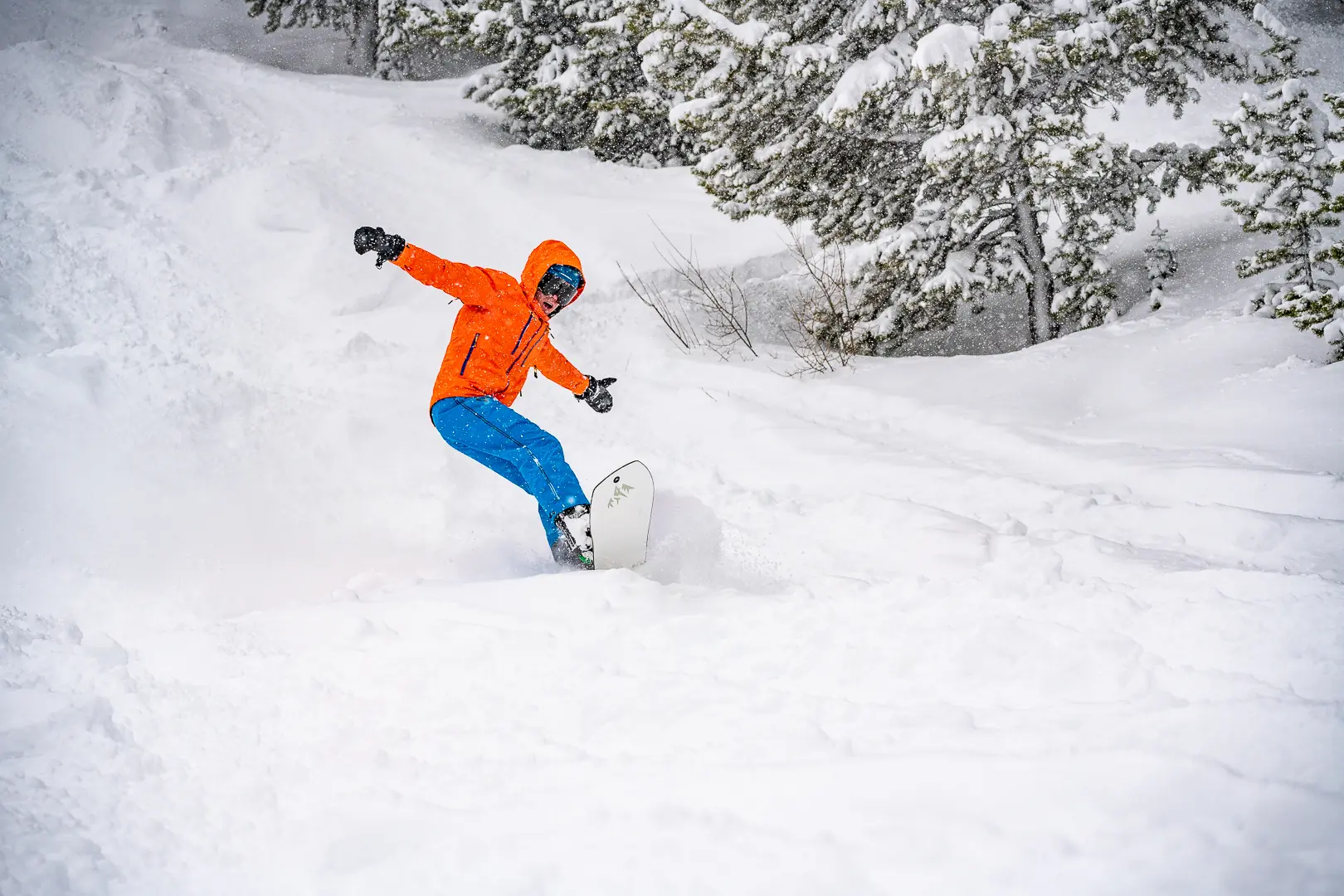



Built-In Gaiters
Snowboard pants have built-in gaiters that open wide and stretch down over boots to the ankle. This is one differentiator between pants that work well for ski boots versus snowboard boots because ski boots have a narrower neck.
In a unique innovation, the 686 has a BOA-compatible gaiter, which is a window where the front-facing BOA — a dial that turns to tighten the cable laces in a boot — can be accessed and stays operable with the gaiter pulled down. Of course, that setup isn’t as effective with dual BOA systems. Find the perfect snowboard boots to match your pants!


Reinforced Cuffs
Reinforced cuffs are a key detail. When we’re at the resort and skating through the lift line or connecting runs via flat meadows or groomed corduroy, it’s easy to beat up the interior pant legs with our board’s metal edge.
When we’re uphilling, kick turns can slice that fabric. During splitboard mountaineering objectives, our crampons easily snatch the other pant leg. For post-ride après, walking around without rolling up our hems wears and tears the fabric, too.
Some snowboard pant designs have additional tough material wrapped around the interior portion of the hem, which also reaches up toward the calf. The textile coat increases the pant leg’s durability and overall lifespan. Once the outer fabric splits, the pant’s waterproof membrane can get exposed and start to shred, so it’s not the easiest fix even if you have a sewing kit.
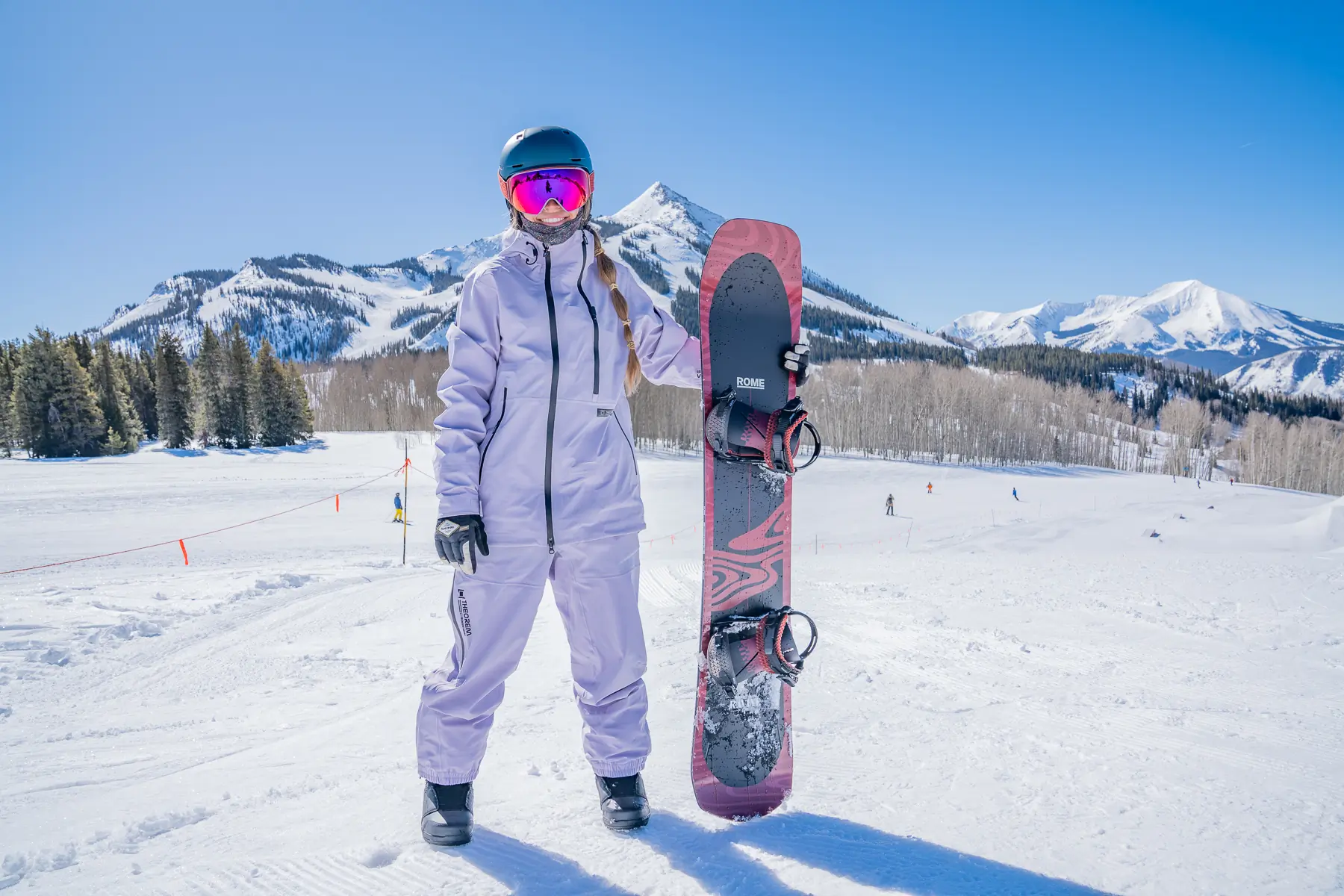



Jacket-to-Pant Interface
A handful of brands feature a system that allows the company’s jackets and pants to connect to one another in order to prevent snow or wind drift on the lift. These styles also provide good protection when we’re bending over to strap our boots into our bindings or when we take a tumble on a rowdy powder day.
Volcom has a superior and proprietary system with a burly zipper that connects the jacket to the pant. It’s durable, comfortable, and easy to use. Other brands, like 686, have fabric strips on the jacket that extend through loops on the pants and snap closed, which helps maintain some connection and prevents a full-on gap in the event of a tumble. Check out the Best Snowboard Jackets to find your perfect snowboard kit.
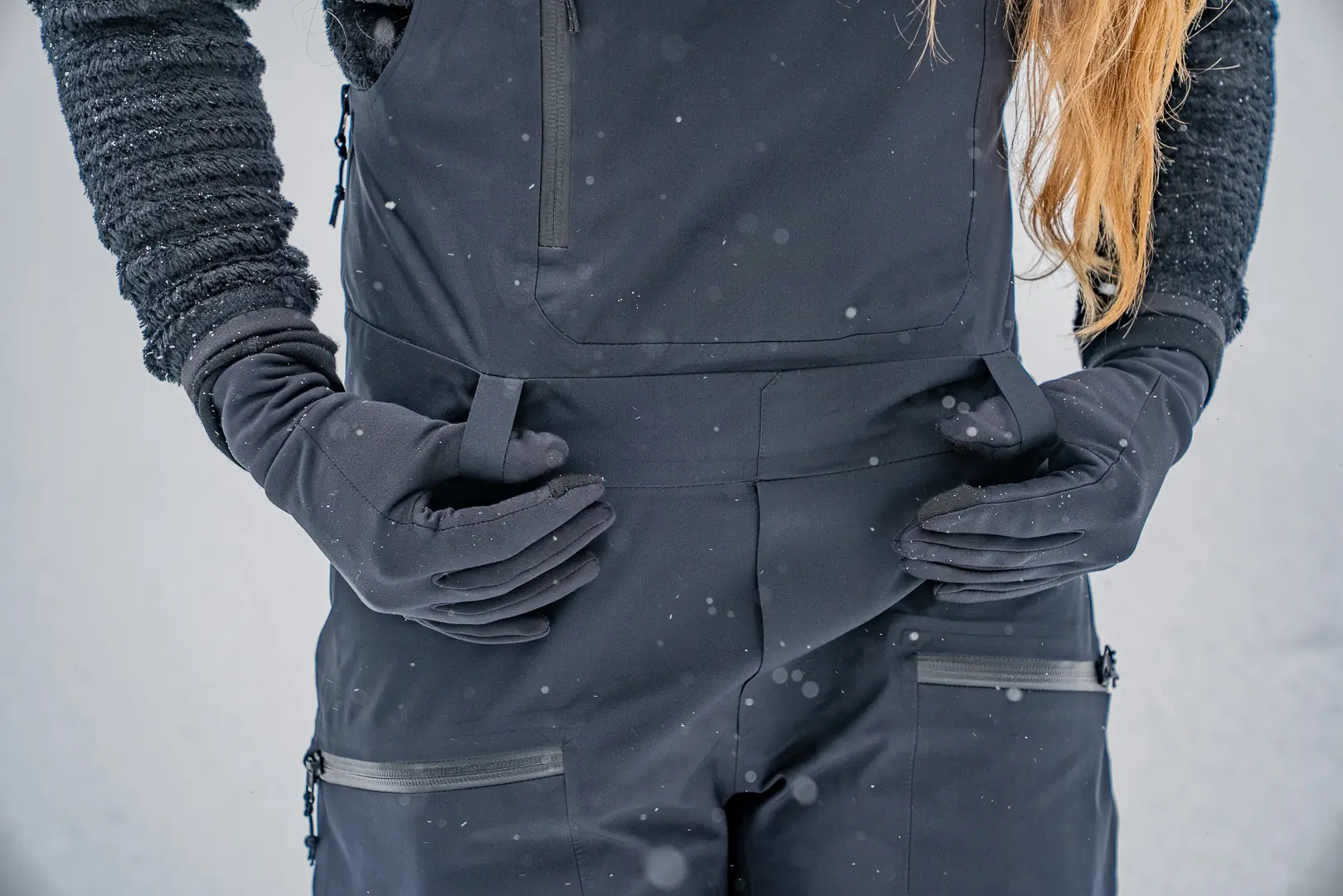



RECCO
RECCO is an integrated lightweight reflector that’s often added to snowsports apparel. It’s a passive, searchable technology that rescuers can use to help locate a lost person.
Organized rescuers use handheld detectors to help find the reflector, which can complement a search during an avalanche burial. From the air, helicopter detectors can also search for a RECCO reflector.
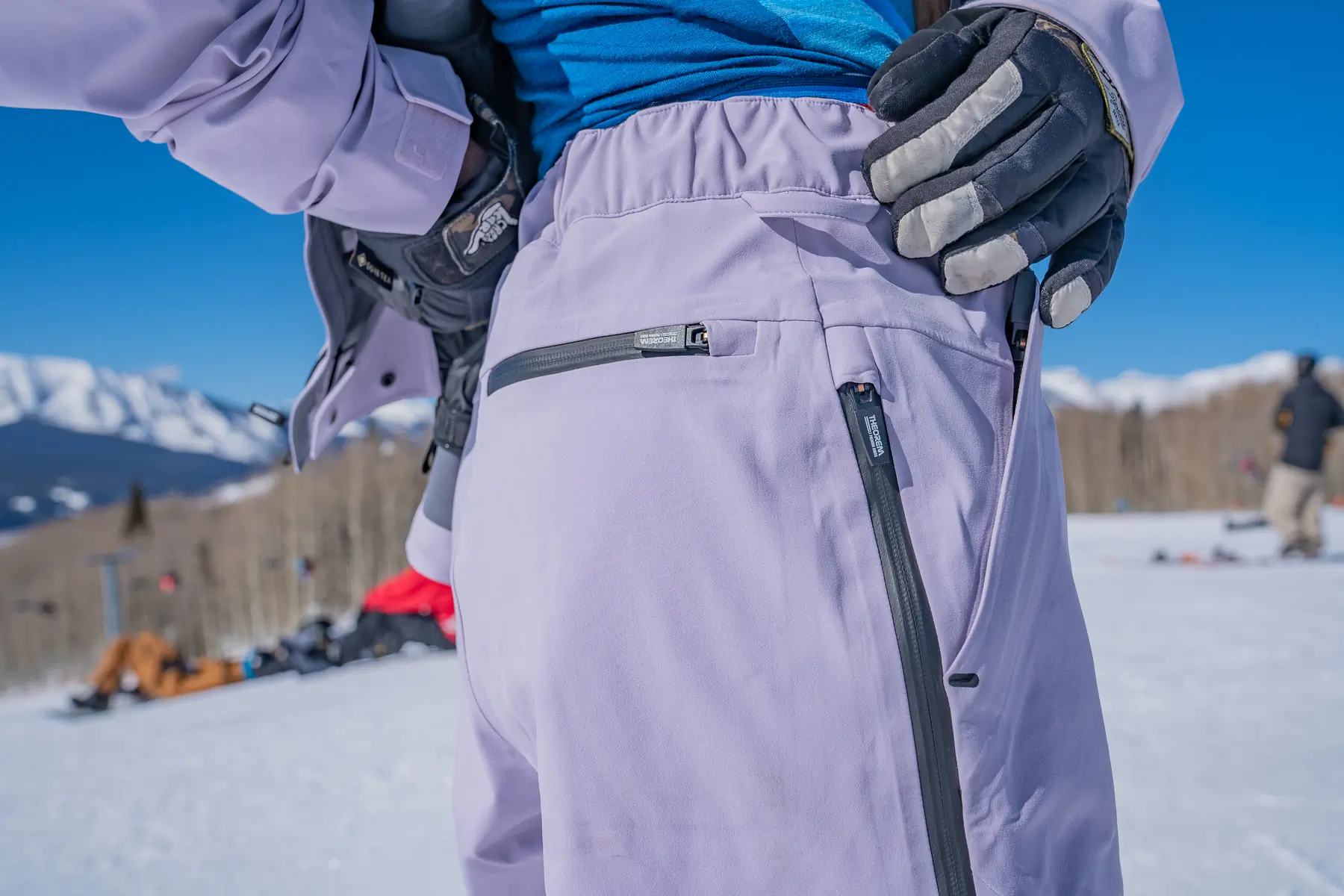



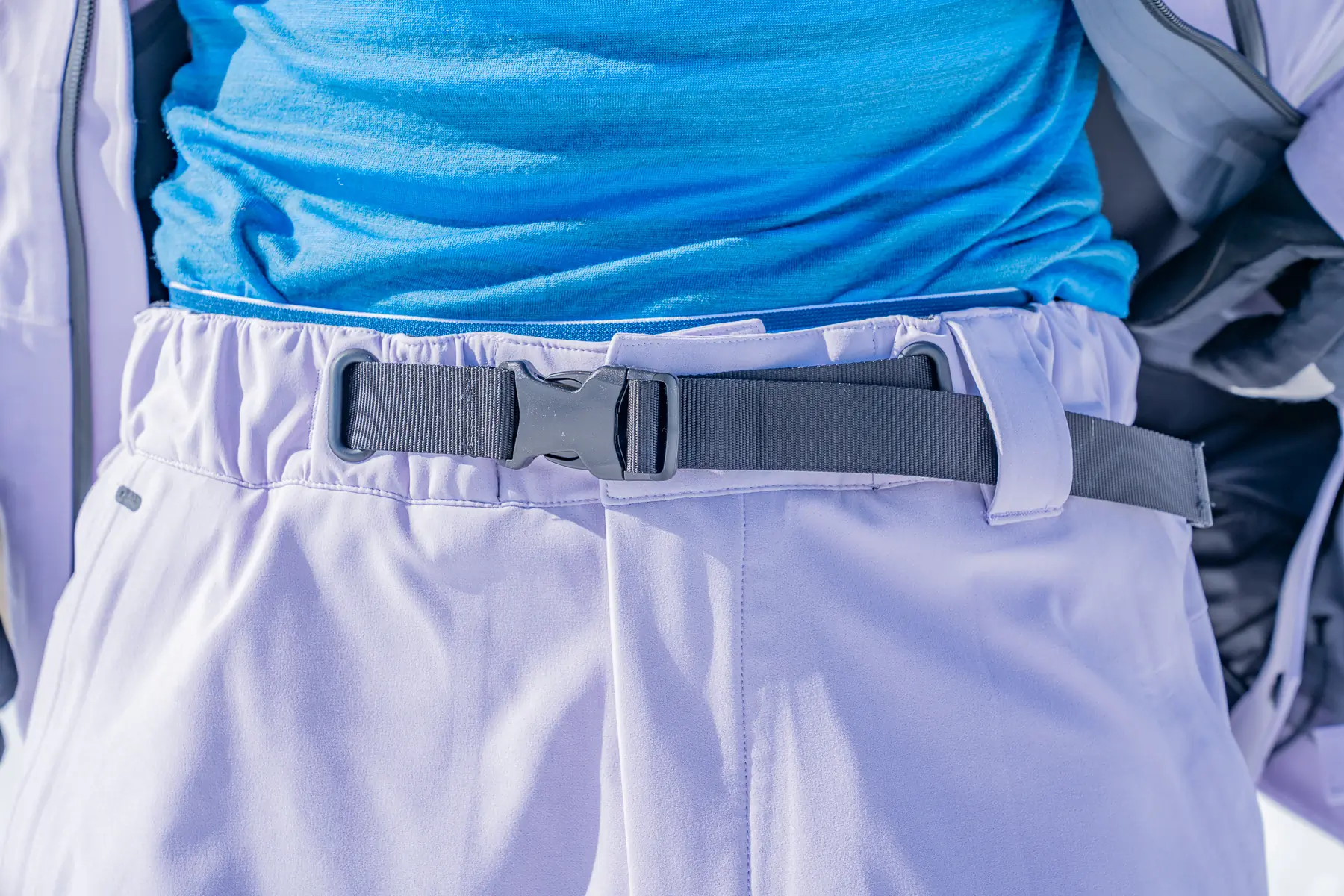



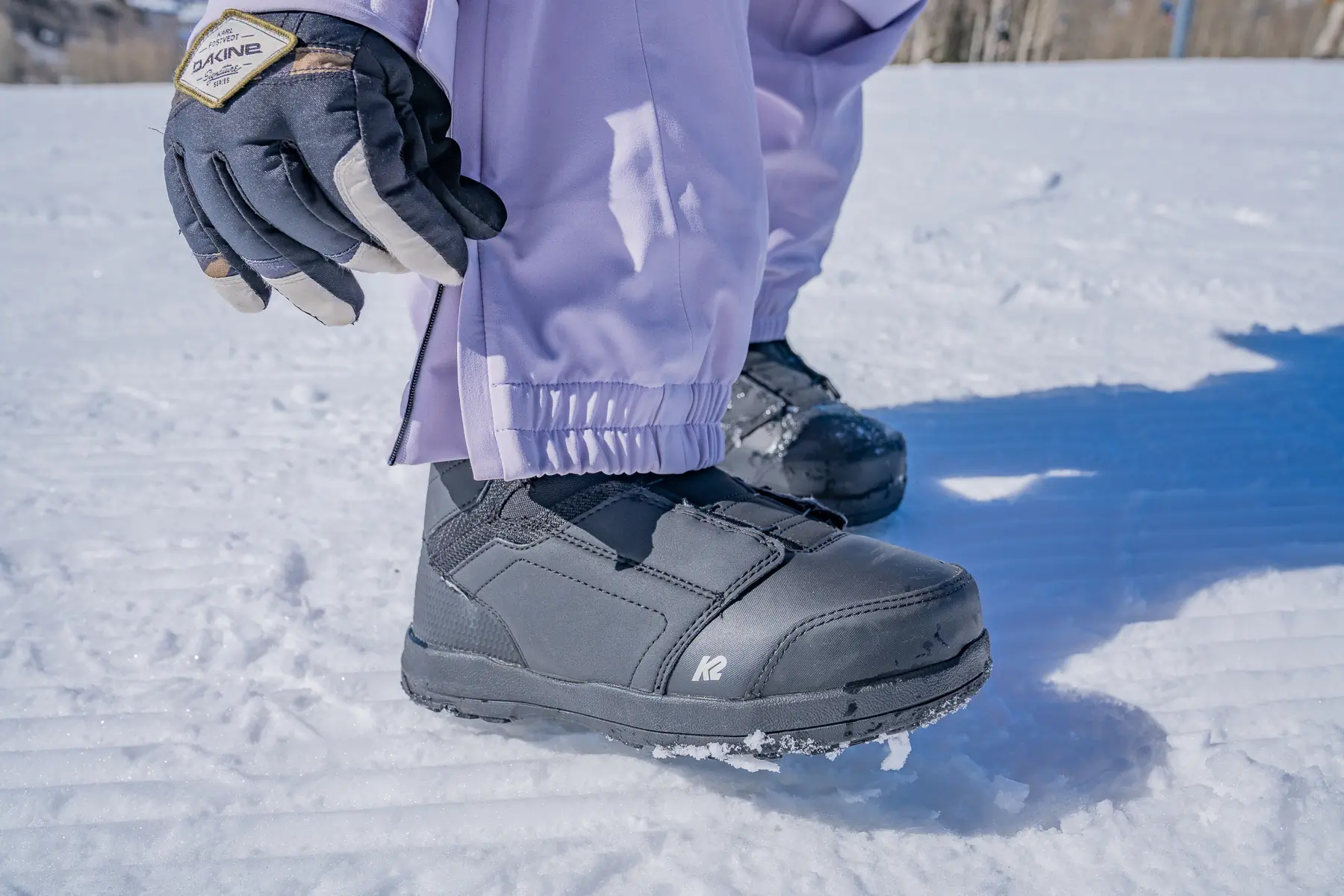



Fit & Function
Well-designed snowboard pants are nicely fitted and articulated for function, which also parlays into style. To be paired with snowboard boots, the hems need to be modifiable and splay at various degrees.
The gaiters need to accommodate the broad width of a snowboard boot, especially if the closure features a BOA system versus traditional laces, which are more streamlined.
Often, the pants are tailored in the upper portion and bell out toward the pant leg hem. The knees are articulated for ergonomics and comfort while cleaning out binding plates and strapping in and out or while jibbing around the resort or park.
For some brands, snowboard pants for men are a bit less form-fitting or athletic-shaped and are baggier compared to designs made for women.
If you think a pair of tailored ladies’ snowboard pants or roomy lads’ snowboard pants would fit your riding style, get ‘em regardless of how you identify.




Price & Value
The prices in our snowboard pants guide range from budget-friendly choices to top-of-the-line expedition gear.
Budget
The North Face Women’s Apex STH Pants ($195) and The North Face Insulated Freedom Pants ($200) are the most budget-friendly in our guide. Lower-cost options are often not as durable, nor will they be as stout against resounding, repeated weather like biting wind, snow, rain, hail, or sleet.
But for mild climates or moderate conditions, budget options can work fine for a handful of seasonal outings at the hill. The budget price rung includes the Burton Cargo Snow Pants ($185), and Roxy Rising High Pants ($210).
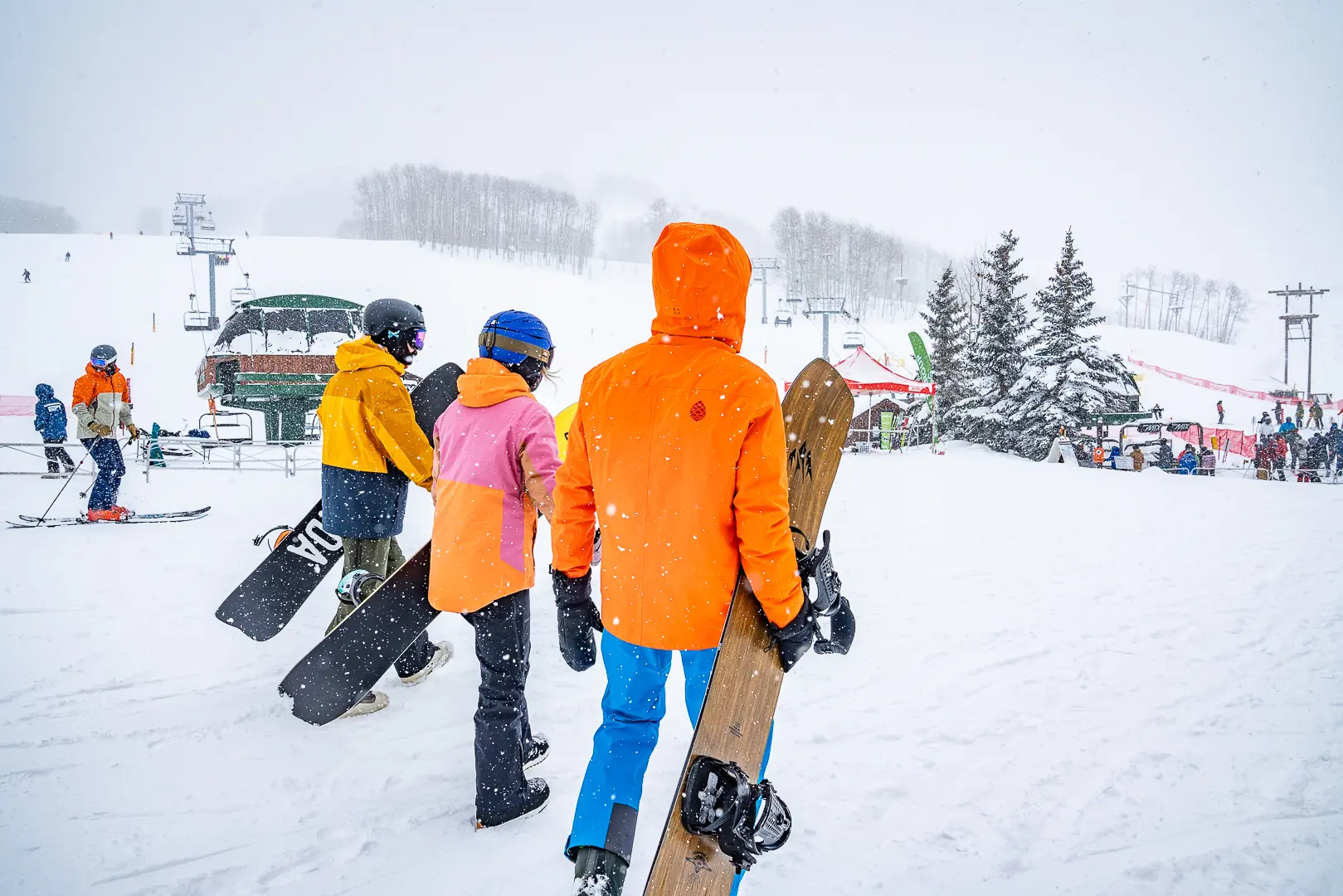



Mid-Tier
Often, the higher the price, the greater the waterproofing, breathability, and fabric reinforcement. You also might notice more pockets, zippered pockets, high-quality zippers, or more fabric in general. The mid-tier ranges from $200 to $300 and hosts the Dakine A-1 Pant ($255), Volcom Aston GORE-TEX Pants ($320), and Volcom L Pants ($320).
Premium
At the top of the shelf, you’ll find the most premium fabrics, construction, and fit. That’ll include the TREW Gear Women’s Chariot Bib Primo ($400), TREW Gear Men’s TREWth PRIMO Bib ($519), and the Dakine Sender Stretch 3L Pant ($475).
Rounding out the top tier of options that have the highest specs is the TREW Gear TREWth Bibs ($499).


Frequently Asked Questions
All of the snowboard pants and bibs we’ve included on this list are high-quality products. But Volcom, TREW Gear, Airblaster, Burton, and Jones Snowboards are a handful of well-established brands that are known for their top-notch outerwear. Many other brands make outstanding products, too.


Snowboarders might find ski pants that are not marketed toward snowboarders that work super well for their riding style and the climate and conditions where they ride.
That said, snowboard pants are designed to fit over snowboard boots with cuffs that expand or have a wide enough circumference to slide over the wider neck of a snowboard boot, which is larger than a ski boot. The same goes for the boot gaiters, which are designed to work with snowboard boots.
Snowboard pants tend to have a baggier fit compared to streamlined ski pants.
On this list, the majority of our top picks are snowboard-specific pants that are optimal for snowboarding. Some pants work for both skiing and snowboarding.
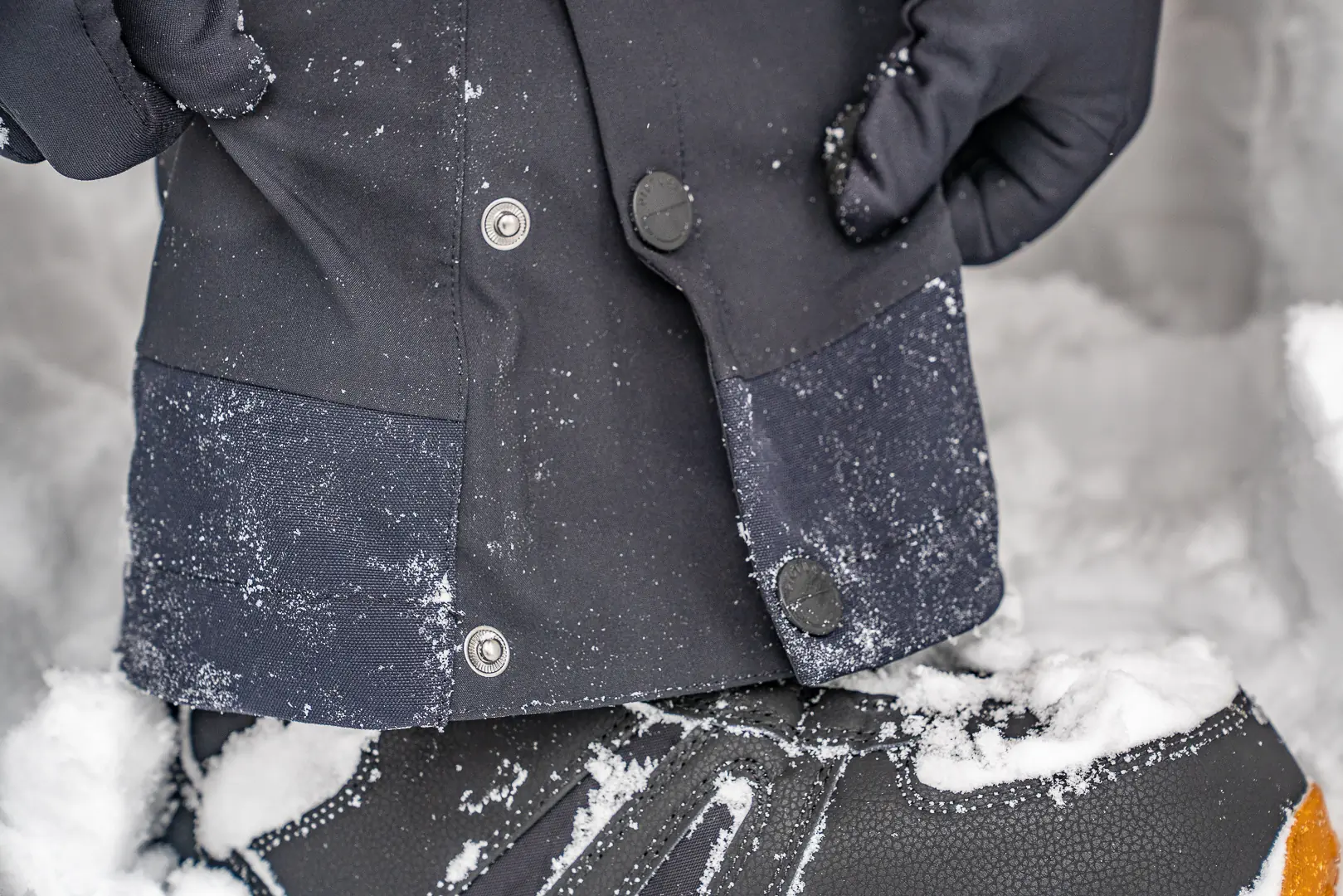



If you tend to run cold or regularly ride in frigid conditions, you may want a pair of insulated snow pants. However, it’s important to note that insulated pants can become uncomfortable when the weather turns warm.
Most riders prefer uninsulated pants for their superior versatility. In cold conditions, layers can always be added for extra warmth.
Insulated pants are not recommended if you plan to boot pack often at the resort or snowboard in the backcountry.
The pants versus bibs decision ultimately comes down to personal preference. Neither is strictly better, though both have a few key advantages and disadvantages.
Bibs are great for keeping snow out while surfing through chest-deep powder and the most popular designs these days have nailed the drop seat, so going to the bathroom is easy for guys and gals in the backcountry or at the lodge. While bibs can offer protection including against the lower back from wind, many bibs are made with breathable materials, so they aren’t too stuffy or hot while they offer a barrier.
Pants are simple, though they can’t keep the elements out as well as a bib can. If you prefer to wear a midlayer beneath a shell jacket or want the quick ease of removing your midlayer midday when it warms up, it can be more comfortable and more convenient to wear snowboard pants versus bibs.
The simple answer is yes. For maximum comfort while snowboarding, you should wear waterproof outerwear, which will prevent your pants from soaking through when you sit down, if you take a tumble, on powder days, and when it snows while you’re on a lift ride or standing in line.
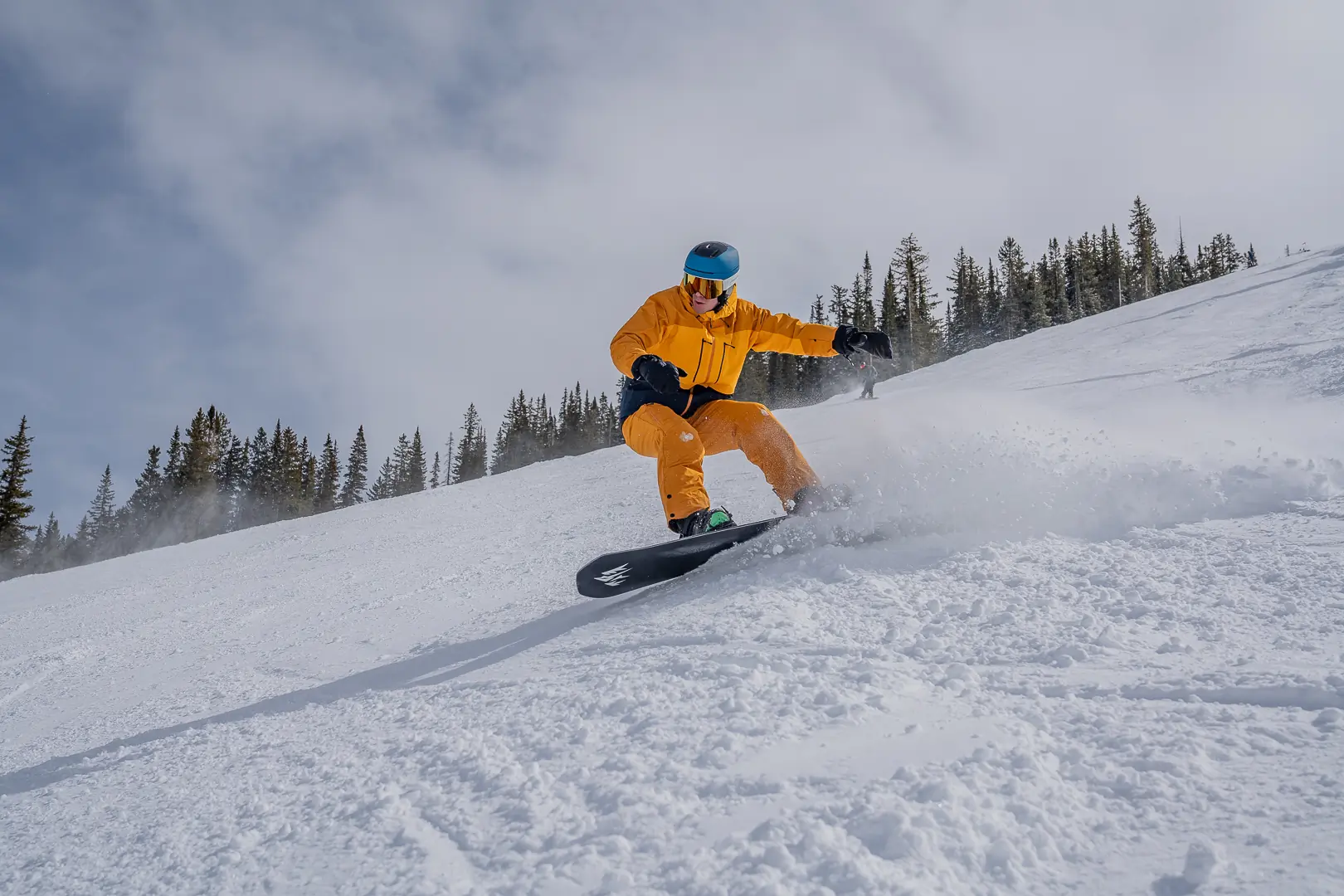



Backcountry snowboarding involves a lot of uphill walking and riding through deep, untracked snow. For these reasons, backcountry snowboarding requires reliably waterproof pants that are also durable, breathable, and relatively stretchy.
A few of our favorite backcountry snowboard pants and bibs include the Jones Snowboards Shralpinist Stretch Recycled Pants ($400) and the Jones’ Men’s Shralpinist Stretch Recycled Bibs ($480).
The simple answer is yes. We highly recommend wearing a baselayer under your snowboard pants. You can check out our Best Mens Baselayer Guide or our Best Womens Baselayer Guide to find the right one for you. You can just wear normal underwear (not recommended) under the pants but remember you’ll have some bare skin exposed once you unzip your leg vents.




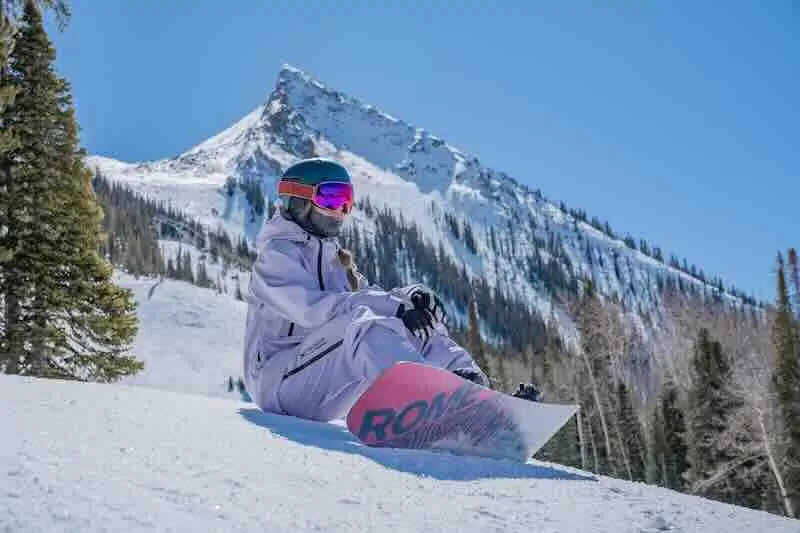

The Best Snowboard Jackets of 2025-2026
From the ski resort to the backcountry, we tested and found the best snowboard jackets for all conditions and budgets.
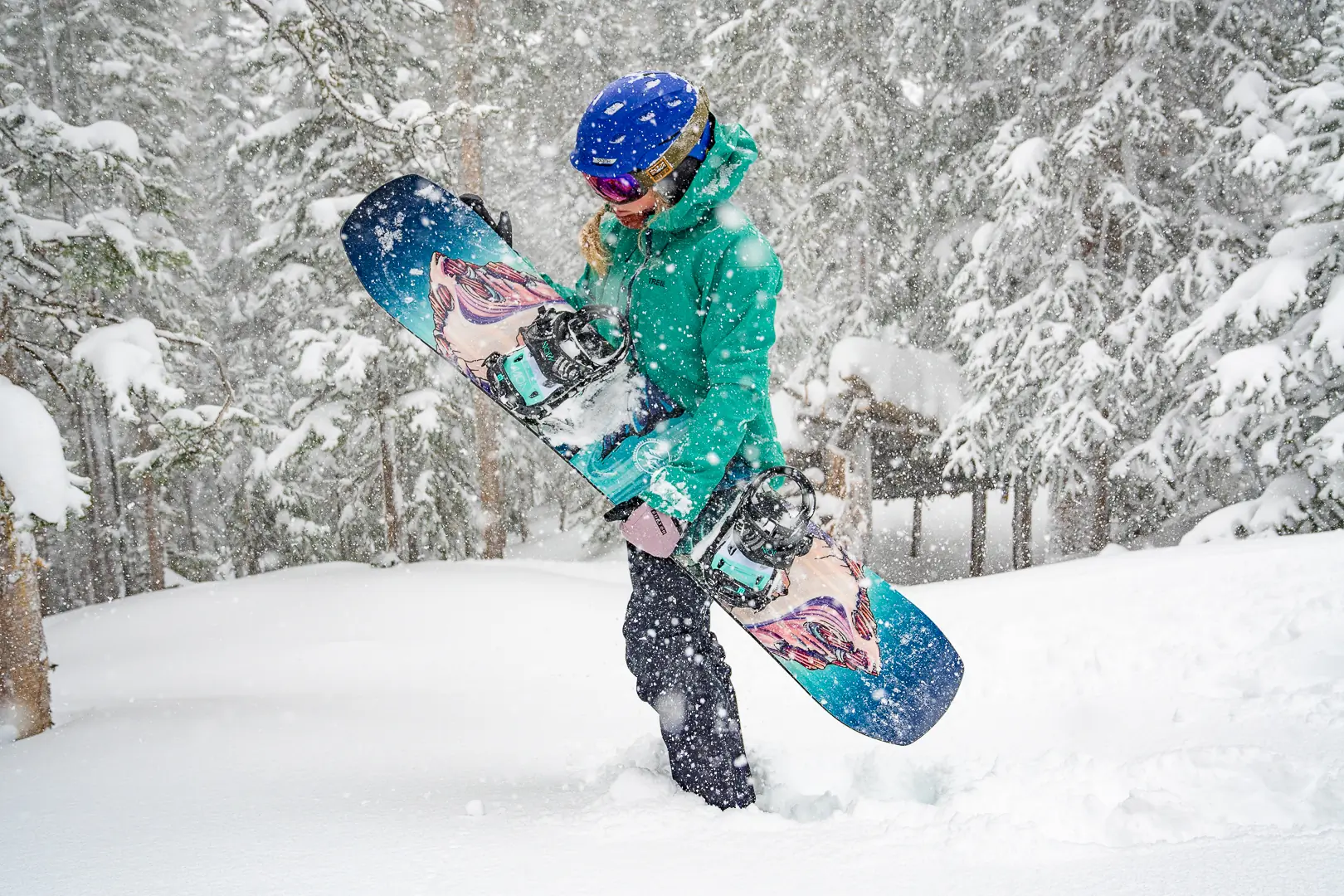

The Best All-Mountain Snowboards of 2025-2026
Our experts tested the best all-mountain snowboards. Top picks include GNU, Burton, and more.
